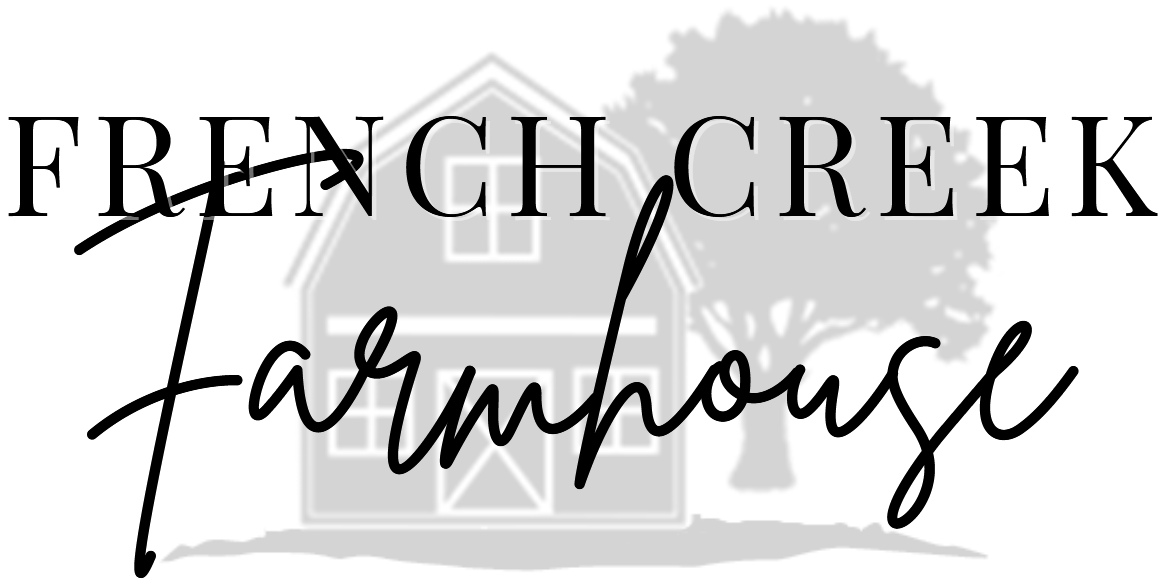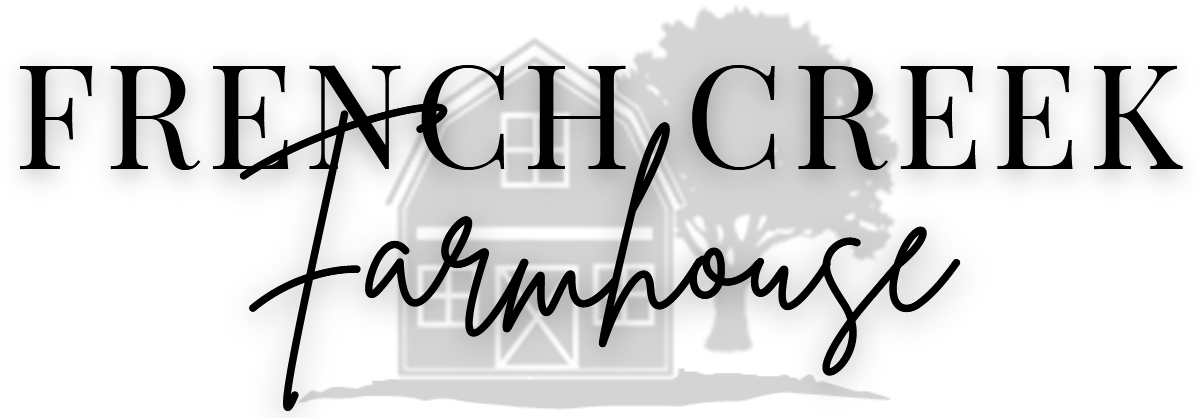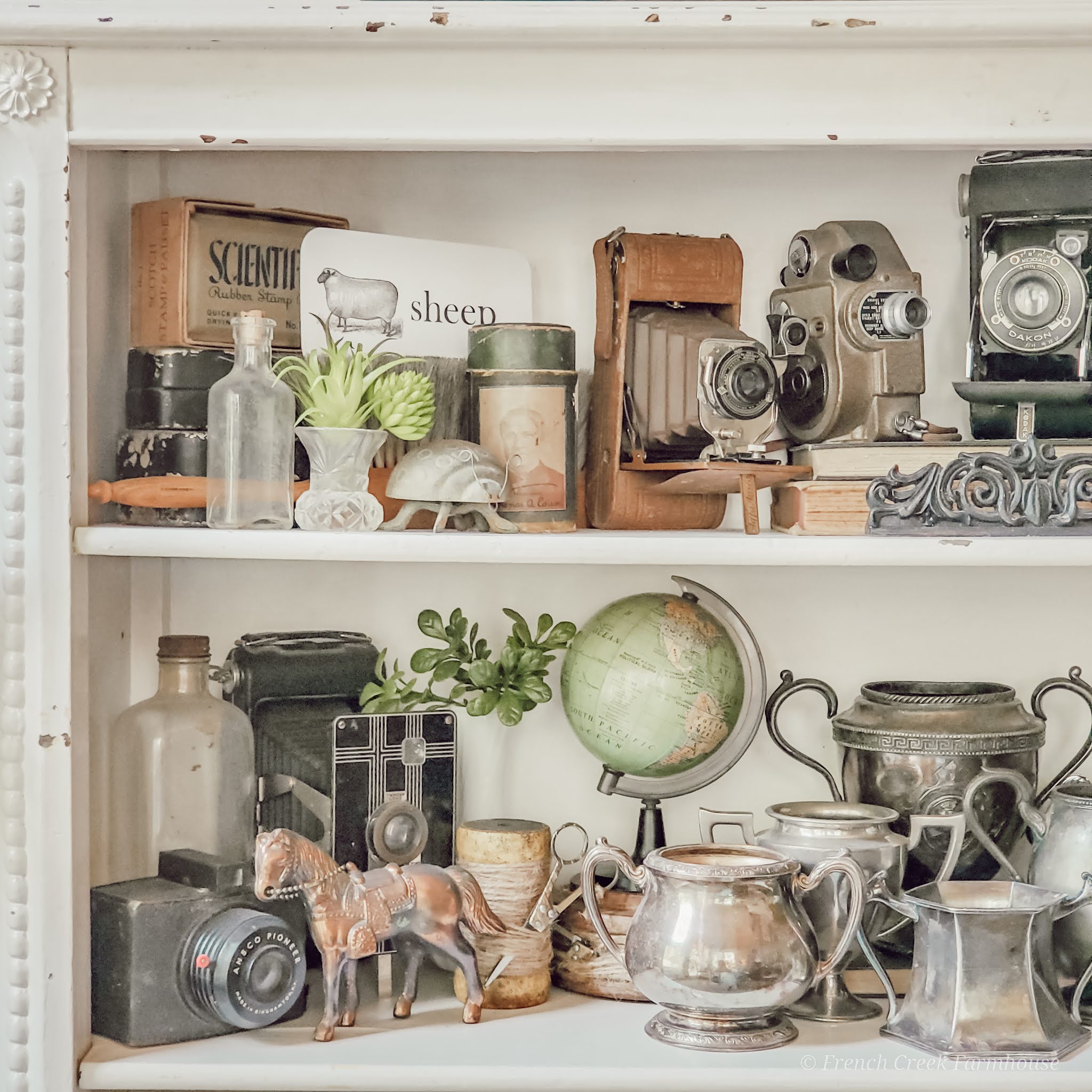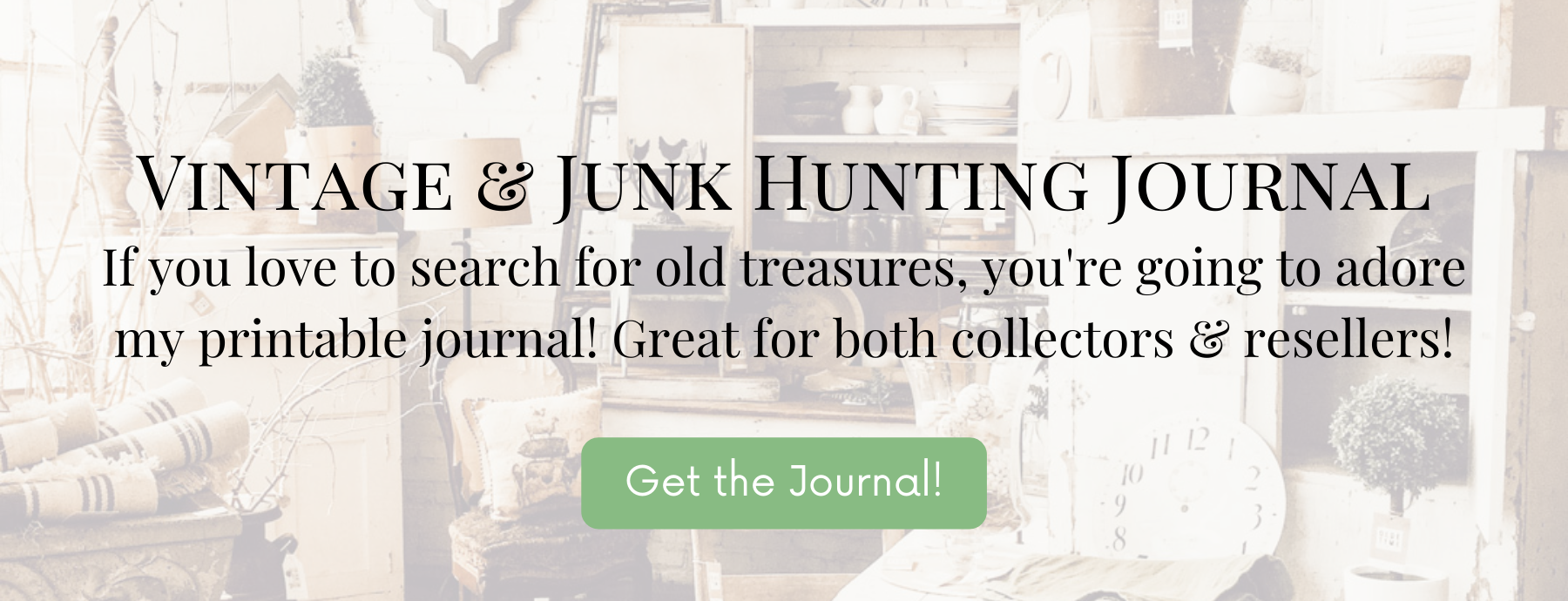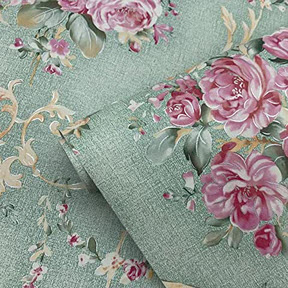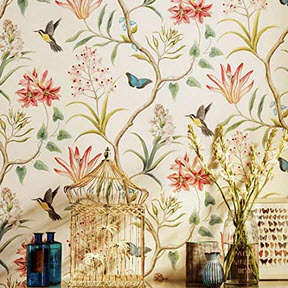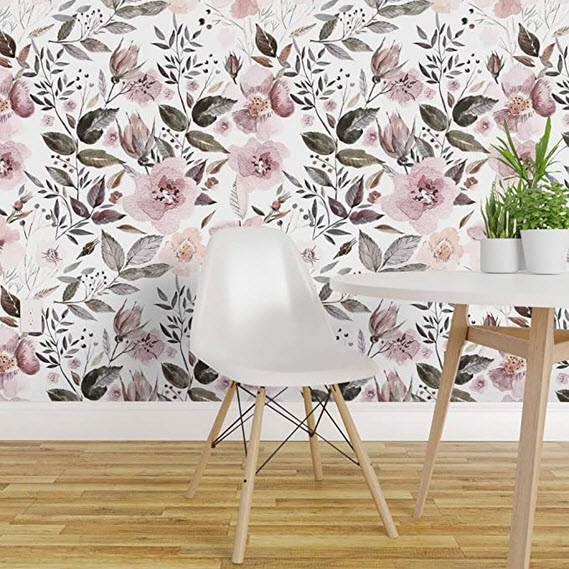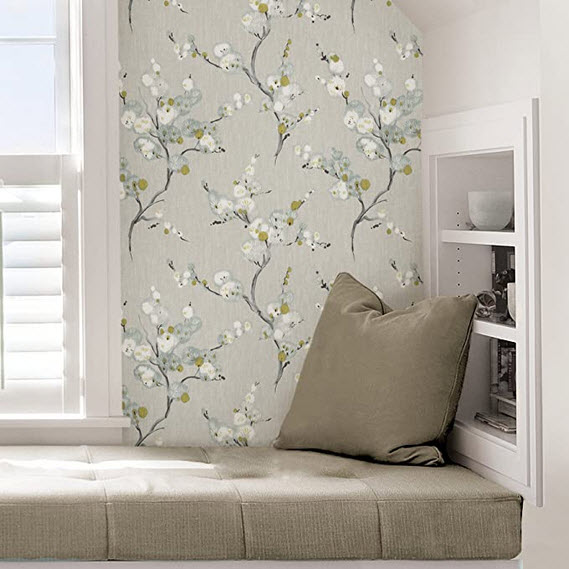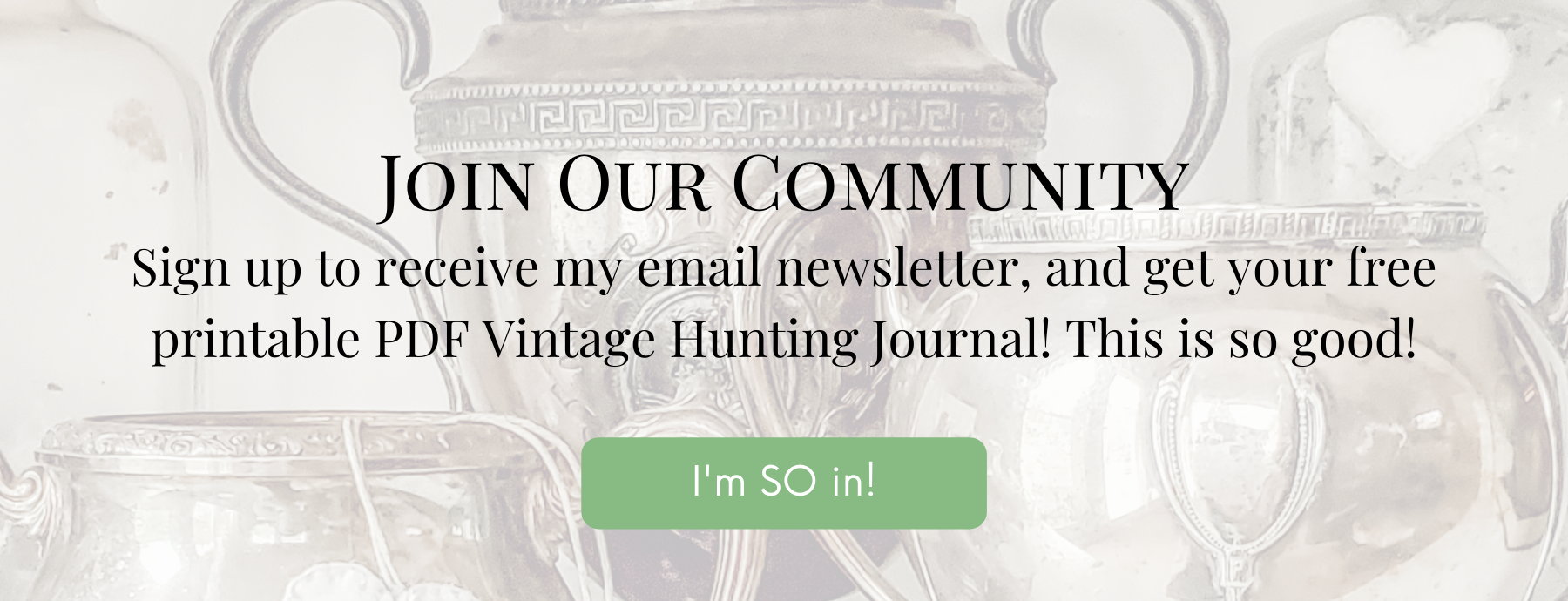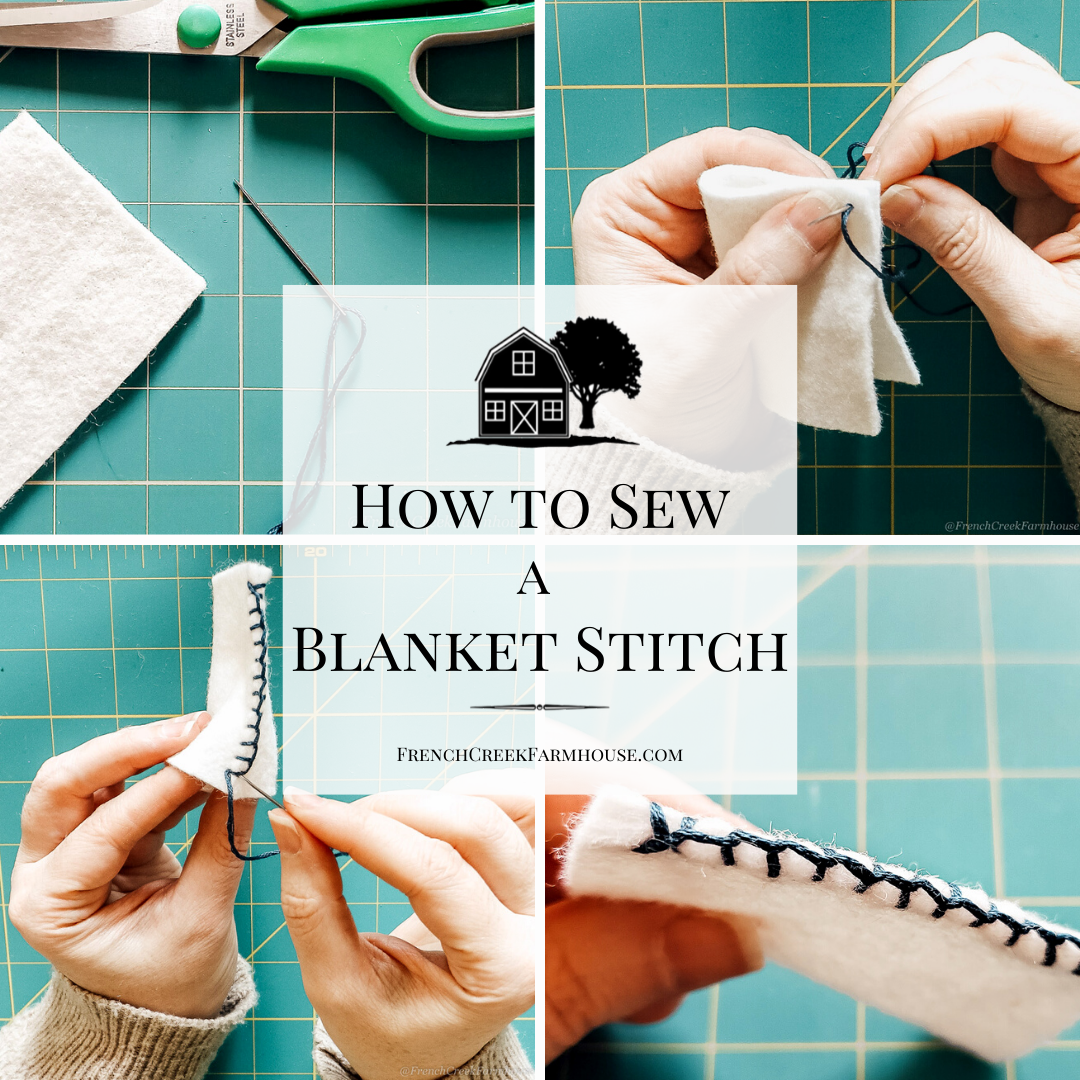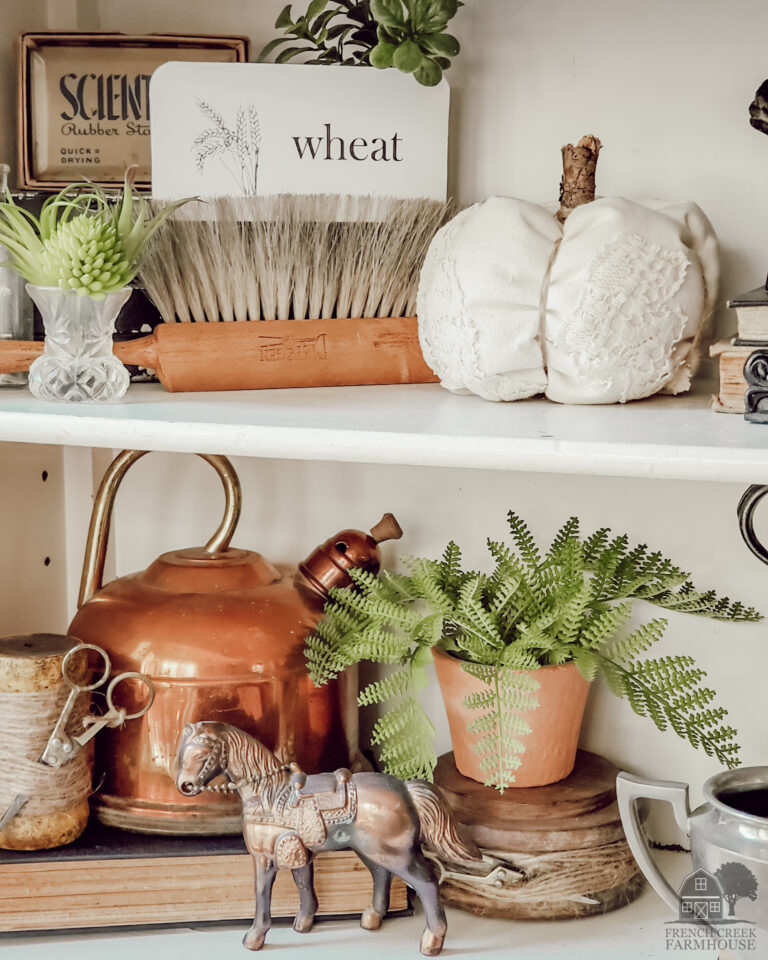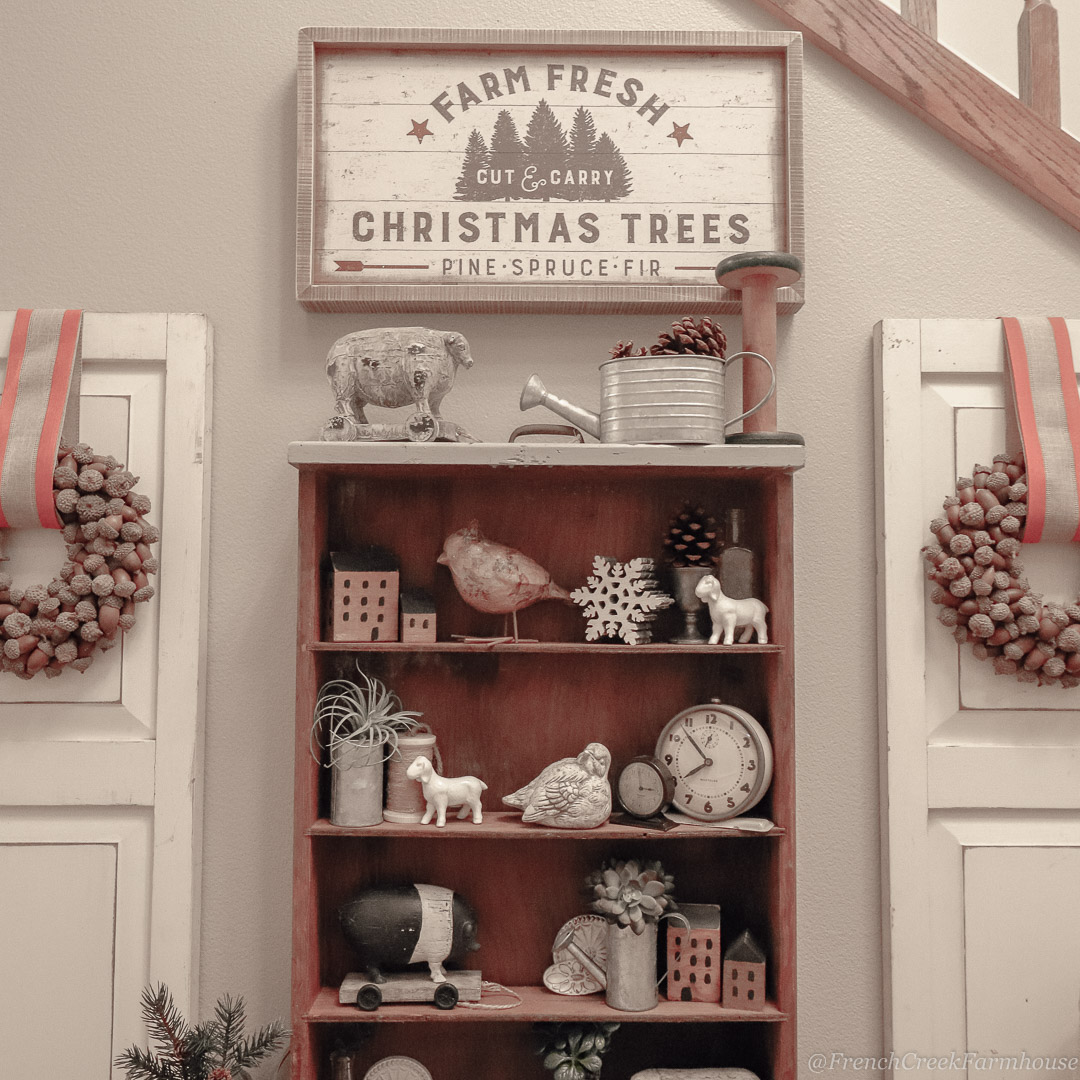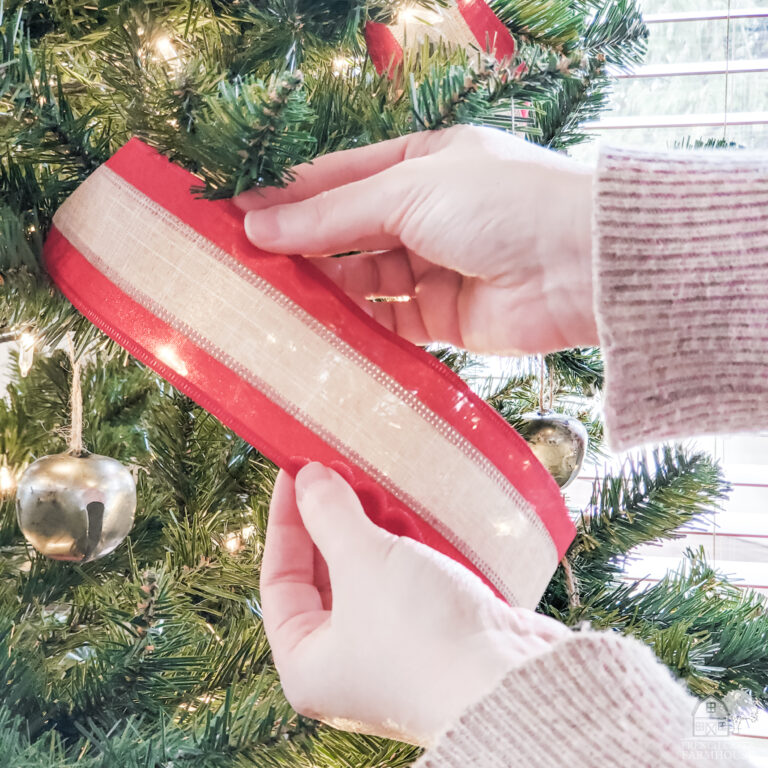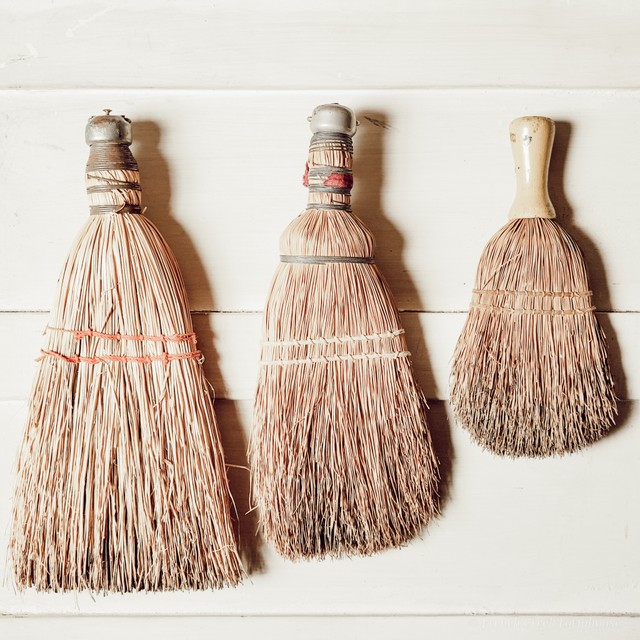How to Style a Vintage Aesthetic Room
I’ve always had a love for vintage items. I love the history of these things so much that it’s just natural for me to want to incorporate them into every room of our home. Unlike the mass produced items that everyone and their cousin can buy from the big box store, vintage items tell a story about where we came from and give the home a uniquely cozy aesthetic.
But if you’re a new decorator, or you’re thinking about changing your decor to the vintage style, how do you know where to start? What’s going to look good, and what will work in your space? It can be so overwhelming!
Take heart, my friend! There are a few simple techniques I’m going to show you that can help you design a vintage aesthetic room so beautifully that everyone will think you hired a professional stylist!
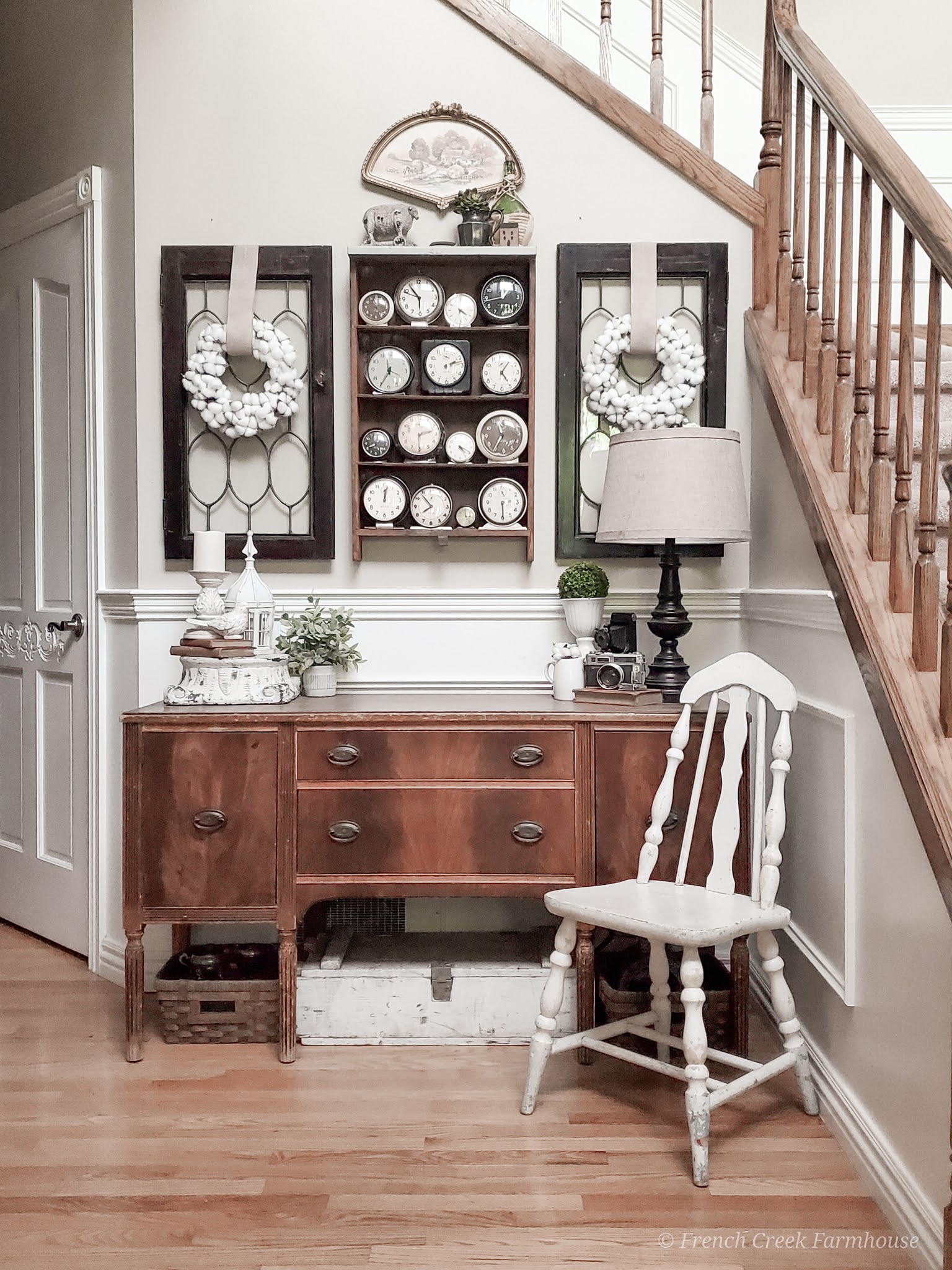
What follows is a comprehensive and thorough guide to understanding how to achieve the vintage aesthetic within your home. The concepts are broken down and presented in simple to understand building blocks, but that doesn’t mean they’re light on substance. Each section is discussed in detail so that you come away understanding all of the components that will go into designing your space.
If you’re an advanced designer, you can skip to the sections that you need most by clicking on each one below. Or, if this is your first introduction to room design, I encourage you to work your way through each section individually so that you have a solid grasp of the building blocks.
In either case, I recommend that you pin this reference guide to your Pinterest boards so that you can easily find and use it again later.
TABLE OF CONTENTS
What is the Vintage Aesthetic?
7 Building Blocks Every Designer Must Understand
25 Vintage Farmhouse Design Elements

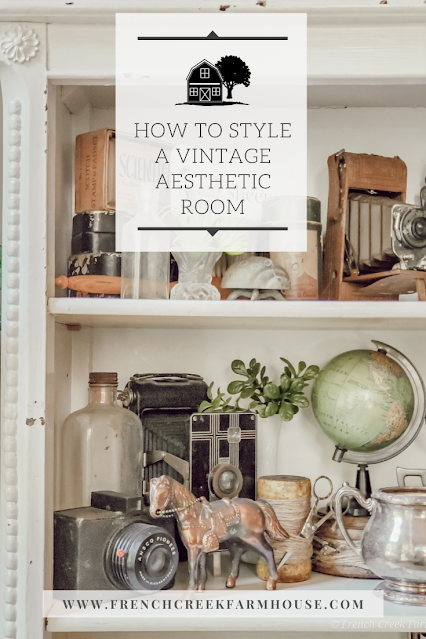
Disclosure: This is not a sponsored post, and I have received no compensation for sharing anything that follows. Some links within this blog may be affiliate links, and I might earn a commission if you make a purchase through that link. This usually amounts to cents, not dollars, and helps to support the projects featured on this blog. I only recommend products from companies that I have found to be trustworthy. Read my full disclosure here.
WHAT IS THE VINTAGE AESTHETIC?
I think it’s important to start by breaking down these terms to understand what is meant by vintage aesthetic.
For starters, the term vintage is often misrepresented. Some people think that anything used is vintage, and this simply isn’t true. Vintage refers specifically to something that is at least 20 years old, but not yet 100 years old (at which point it would become an antique).
Aesthetic is an interesting word that’s often also used incorrectly. Aesthetic is confusing to most people because it can be used in adjective form, or as a noun. Of course you remember from way back in your school days that adjectives are used to describe nouns…so, therein lies the confusion for many people.
Oxford Languages breaks it down like this:
aes·thet·ic
/esˈTHedik/
adjective: concerned with beauty or the appreciation of beauty
example: “the vase of flowers is aesthetically pleasing”
noun: a set of principles underlying and guiding the work of a particular artist or artistic movement
example: “this home is designed according to the farmhouse aesthetic”
So, what we’re going for in this room design is a style of decor that is between 20-100 years old, also known as…everybody, now: the vintage aesthetic!
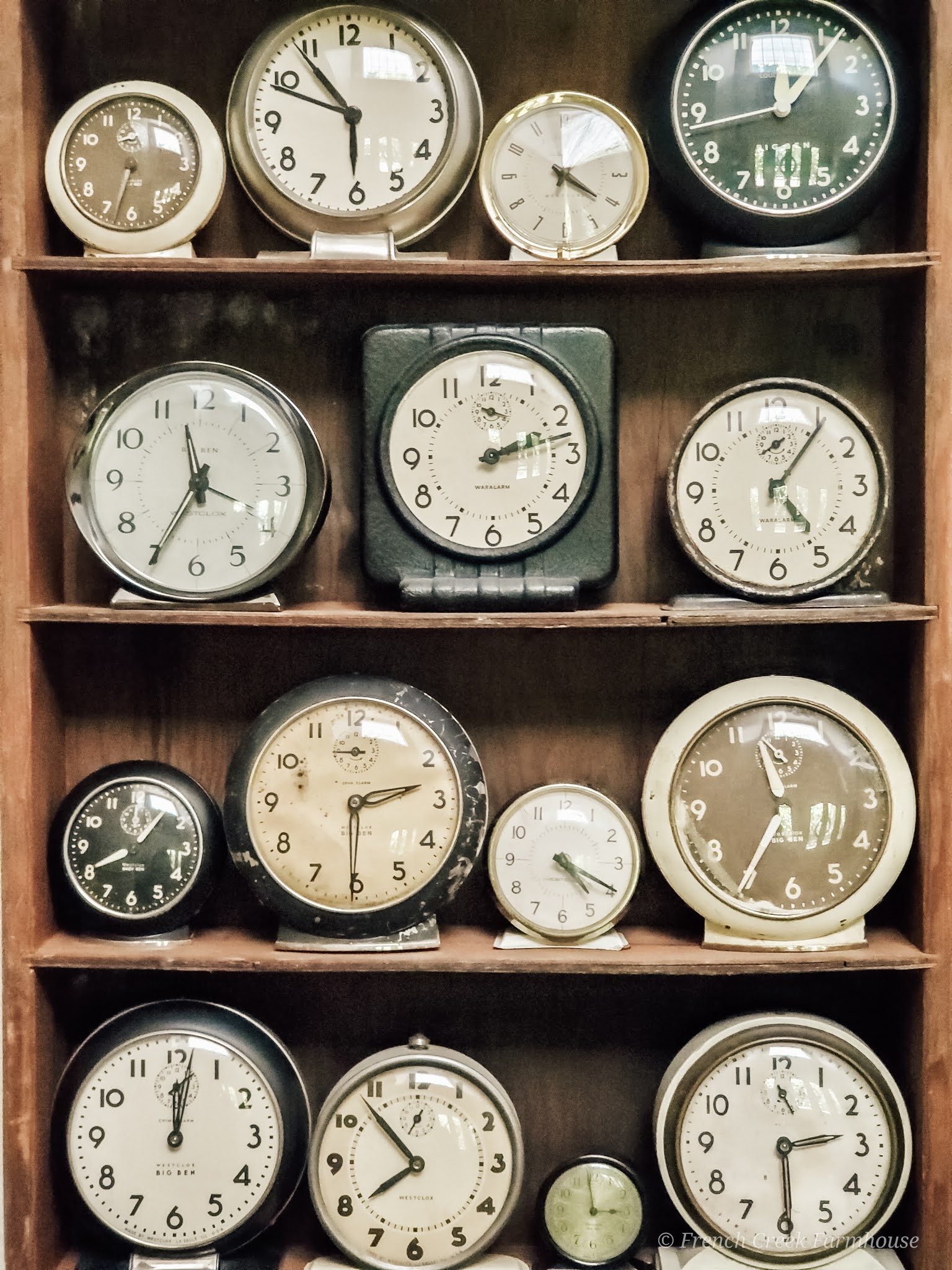
I think it’s also important to note that most people will happily mix their vintage items with their antiques. If you love old things, it goes without saying that you wouldn’t turn up your nose at a beautiful 150 year old relic!
You’ll also find that many people are happy to incorporate reproduction pieces (aka “repop”) into their decor that may have the look of vintage or antique items, but are actually mass produced overseas. Is this acceptable? The answers you’ll get to that question will vary wildly depending upon how much of a purist the collector is.
Some people will absolutely scoff at the idea. They would never consider bringing a “knock-off” into their homes to detract from their collection of genuine vintage and antique pieces.
Other people will decorate their entire homes with repop items that are inexpensively made and purchased at a bargain (often with their…ahem…weekly 40% off coupon?) from the big box stores.
And then you have the in-betweeners who love vintage and antiques, but might still be hunting for their treasures, and so they’ll mix reproduction items into their collections as placeholders until later.
Only you can decide what’s acceptable for you and your home, and no one else should be the judge of what brings you comfort and joy.
If you ask me, I think that we’re all just doing the very best we can to create homes that make us feel good. I don’t believe that you should put off creating that feeling for yourself and your family simply because you can’t do it to someone’s version of ideal.
There will always be critics because judging what others do is a cheap and easy sport. Don’t let that stop you from designing in your own way. You should never compare your Chapter 1 to the middle of someone else’s book–you do you!
If you love collecting vintage items, be sure to get my printable Vintage Hunting journal! You’ll be able to keep track of your finds, make notes about your favorite shops and markets, and even keep of record of items that you re-sell…everything you need is covered in this guide!
THE 7 BUILDING BLOCKS EVERY DESIGNER MUST UNDERSTAND
In this section, as well as the section that follows, we’re going to talk about the fundamental framework of design. Technically, these seven building blocks are used in conjunction with the five principles that follow in the next section, but these concepts are easier to understand when we break them up.
A simple way to think about it is this: these seven elements are the ingredients, and the five principles that follow are the tools with which you work those ingredients. Make sense? Okay, let’s get into it.
In this section, we’re going to cover the following essential design elements of:
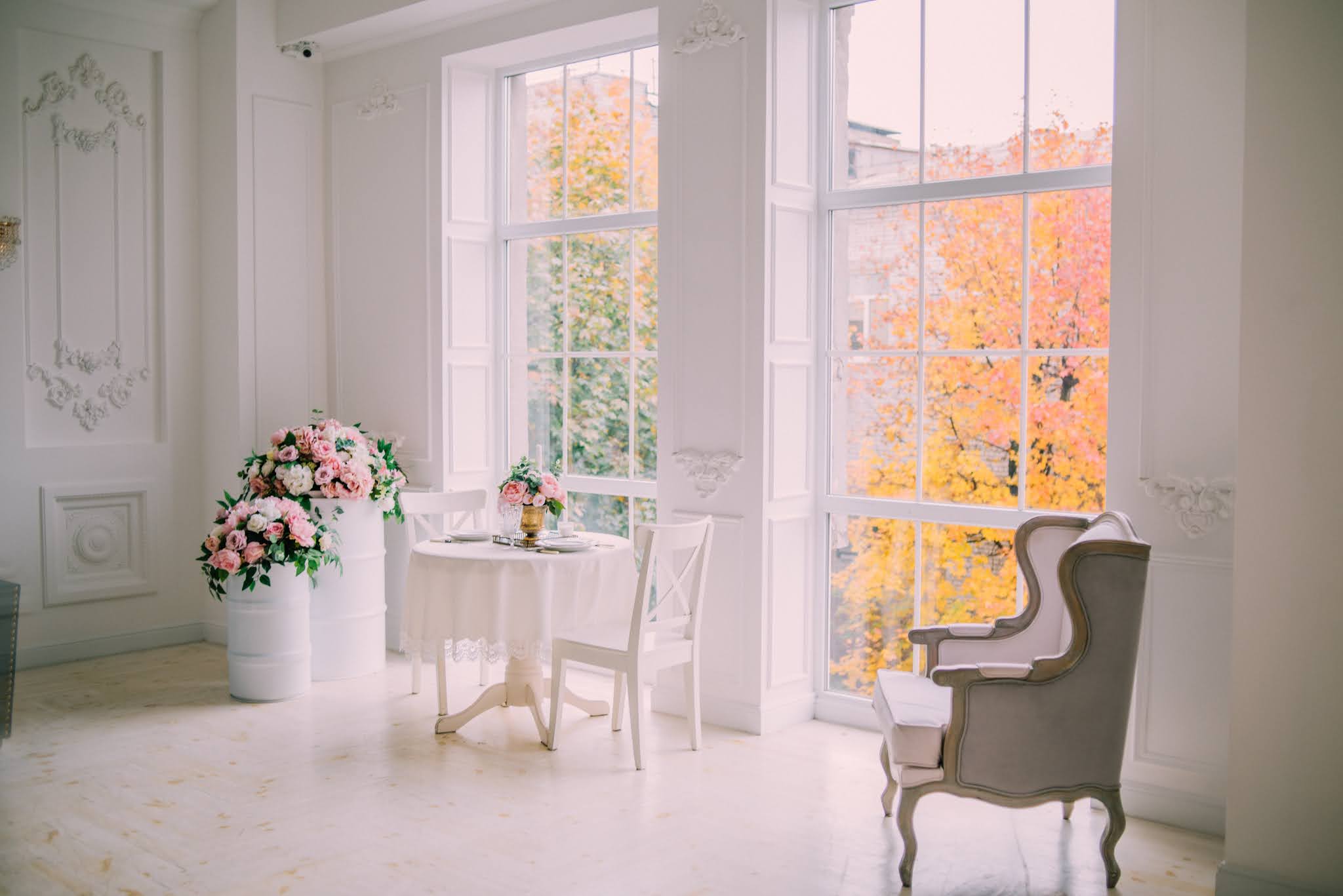
Light
For me, light is the single most important design element, so this has to be the first building block whenever I’m designing a space in our home. Everyone’s different, but light will make or break a room for me–and especially natural light.
Sometimes, though, you’ll have rooms that don’t start with the natural light you crave, and so thinking about how to create light in a room is a big part of the equation. Obviously, you can do this with artificial light (ceiling fixtures, sconces, lamps, etc), but you can also add light to a room with mirrors that reflect it from other places or even through the use of color (which we’ll talk more about in a moment).
You’ll especially want to think about the type of light that’s best for the space you’re designing. For example, we use these bulbs throughout most of our home because they offer unbeatable clarity and purity that makes colors look especially true.
However, in a bedroom, for example, you might prefer a more cozy, soft light more like these bulbs. Or, if you really want to go all in with a vintage vibe, these bulbs might be perfect for you. It’s all about the feeling you’re striving to create!
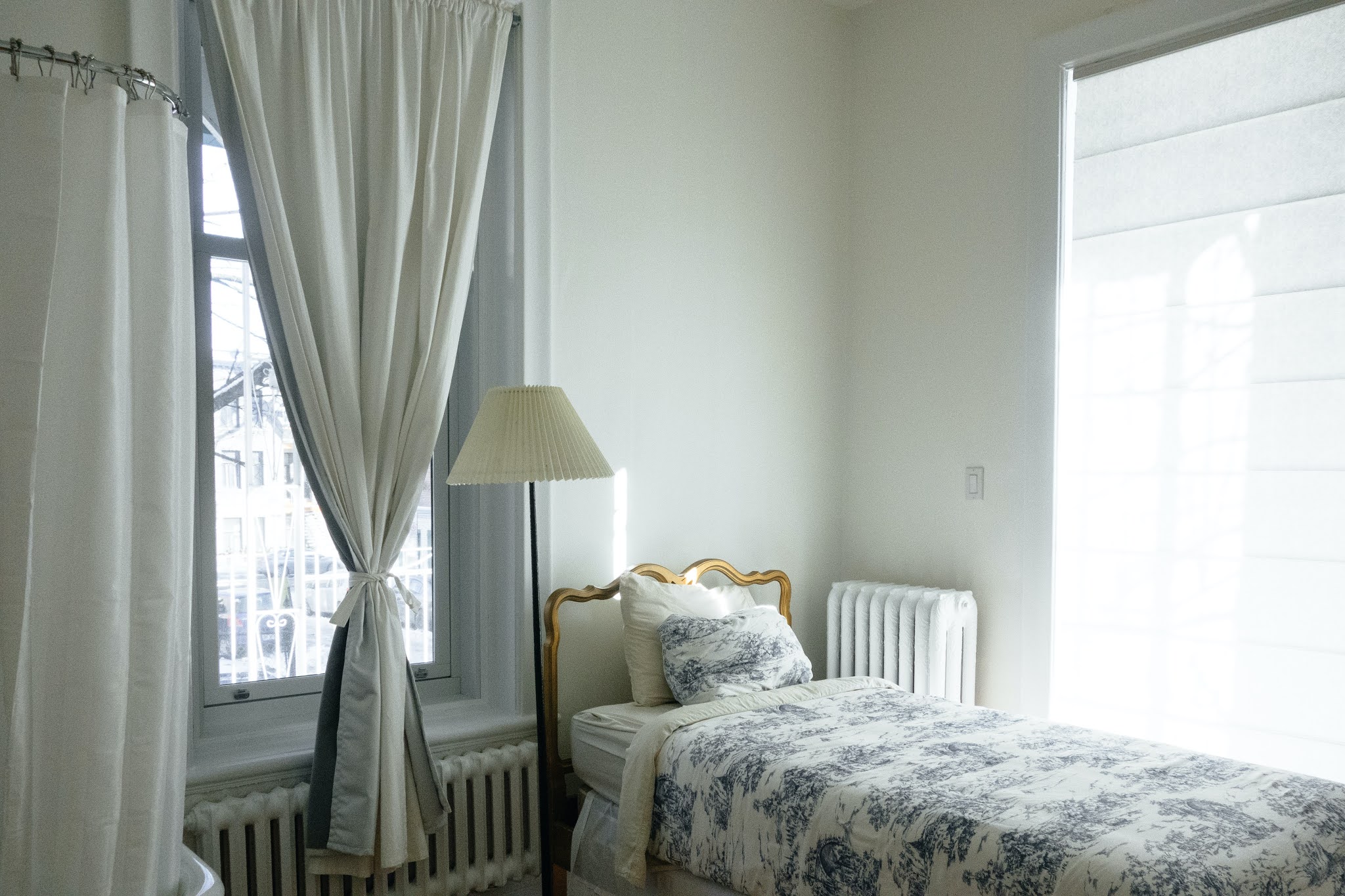
Space
It was a toss up whether to talk about space or light first when discussing these seven elements. For me, light is fundamental regardless of the space, so I just had to put that first. But it really is like splitting hairs.
Space is the canvas the designer has to work with, and it’s divided into two concepts: positive space and negative space.
Most people understand positive space very well. This is where the things are. For example, your furniture, pictures on the wall, vintage treasures on a shelf, etc.
What’s problematic for many new designers is how to use the negative space–the blank areas where there are no things. Negative space is every bit as crucial to a design as where you put your sofa and chairs, and it is often sorely overlooked.
Negative space works just like any other design element to create the illusions of movement, height, breadth, length, and to draw the eye where the designer wants it to go.
Ignoring negative space will make a design feel crowded, noisy, and in disarray–the exact opposite feeling you want to create within the sanctuary of your home. And also not at all in line with the style of a vintage room.
The reality is that people simply didn’t accumulate as many things in the past the way we do today, so to really make sure you’re achieving the vintage aesthetic in your room, pay attention to your use of negative space.
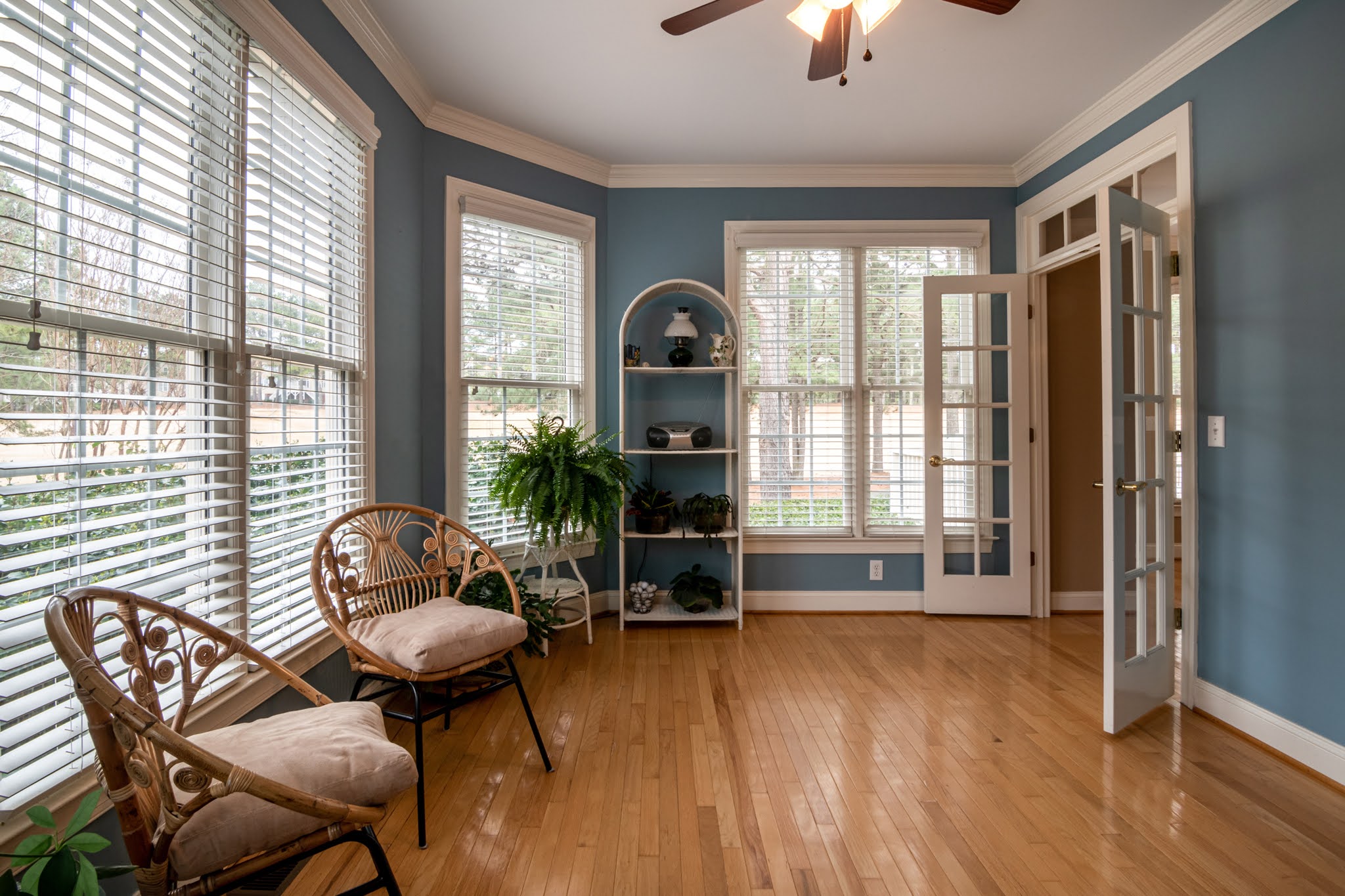
Color
When you think about color, what you really need to be thinking about is mood. That’s because color plays a heavy role in our psychology. And in the vintage aesthetic, you can pick the color palette that suits your preference because all colors are fair game.
If you want to evoke a serene and airy feeling, you might want to stick with a light and neutral color palette. Those who prefer more energy or whimsy might choose bright colors or vintage pastels. And if you want that sort of hunker-down-intensity, consider using dark, rich colors.
I also believe that it’s perfectly acceptable to design for the specific space. I know that some designers want the entire home to have the same aesthetic, but I think that rooms can have different energies and still feel cohesive through other design elements.
In our home, for example, our kitchen and breakfast nook both incorporate vintage pastels that are slightly muted, and my home office is decorated with brightened up versions of jewel tones, because I like the burst of energy that these colors bring to those spaces. But the rest of our home is very neutral because I find that the feeling of calm that comes with those colors helps to soothe and bring us comfort.
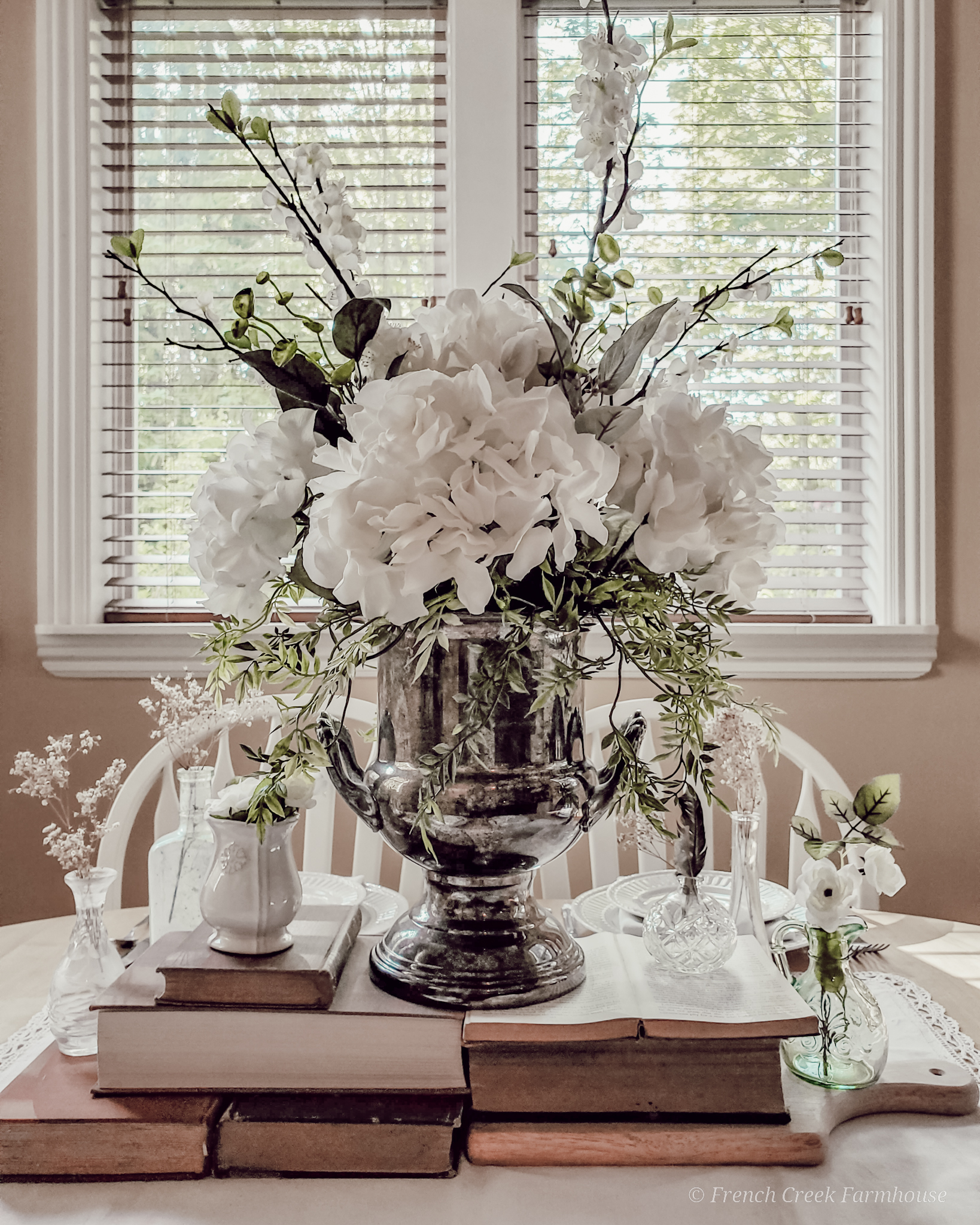
Shape
Often referred to as form, this element is all about the shape of the items in the room. And, also maybe the shape of the room, itself. Things to consider include geometric shapes, such as the trim work or furniture that add hard, angular edges, as well as organic shapes that are more natural and flowing.
I think you need both types of shape in any room. Think, for example, of a beautiful floral arrangement on top of a table. There’s a nice balance between geometric and organic shapes in such a view, and each makes the other more attractive.
When designing a vintage style room, you’ll want to pay attention to the shapes that fit with the era and style on which you’re focusing. A craftsman style cottage has a different form when compared to a southern colonial farmhouse or a French countryside chateau. Make sure to do some research into the style and period that you’d most like to use in your space to see what would be a good fit.
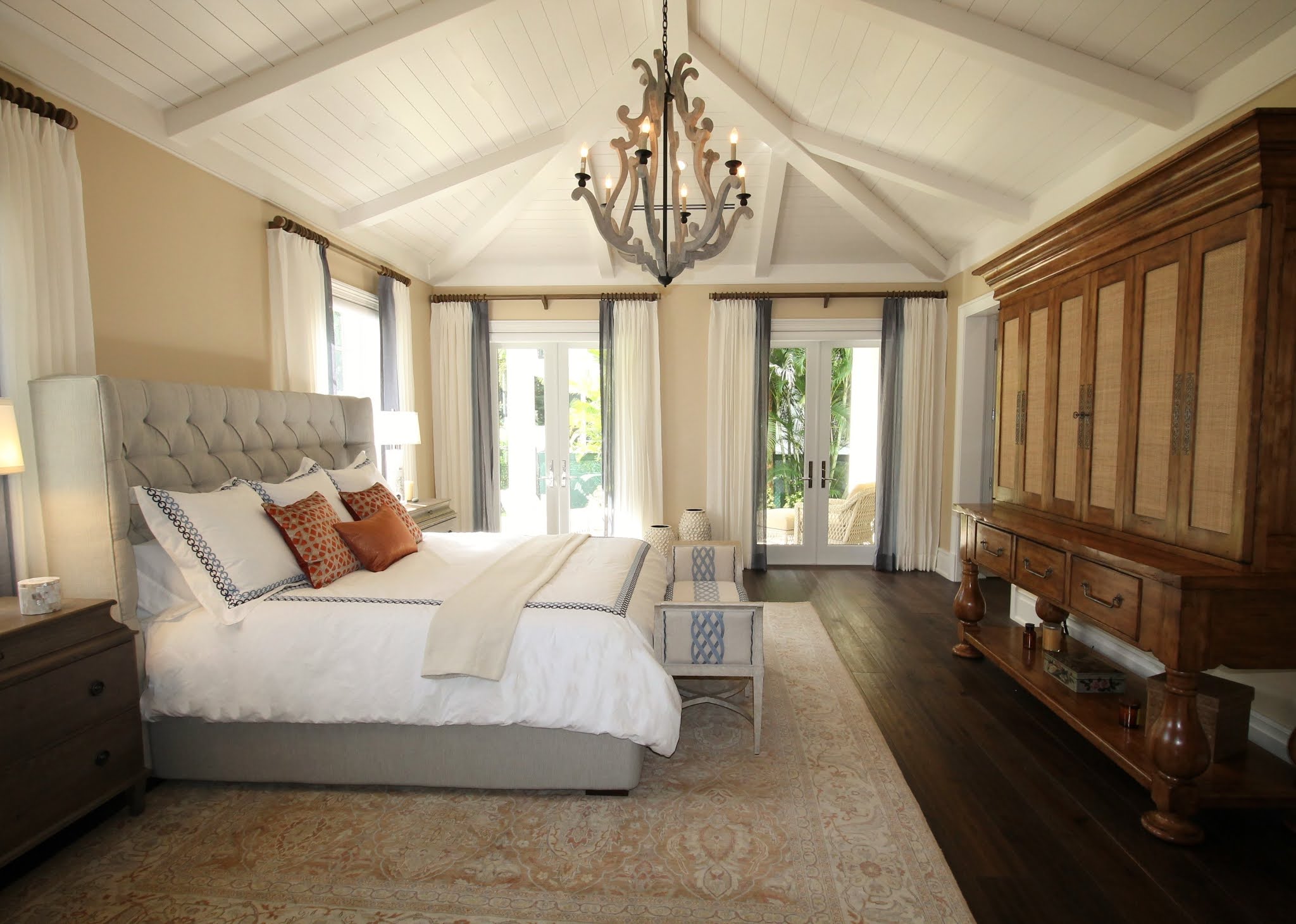
Line
I do think that the most difficult element for designers to master is line. Lines are used to create illusion or direct the eye, so it requires an incredibly special touch to do it correctly…or more importantly, to not do it wrong! It might sound like I just said the same thing in two different ways, but trust me, there’s a big difference.
Lines can be either horizontal, vertical, or dynamic.
Horizontal lines (think: countertops, tables, shiplap) will make a space feel grounded and secure. When lines are horizontal, the goal is to create stability.
Vertical lines (think: doors, bookcases, tall windows, interior walls) will give the perception of height and draw the eye upward. But it’s important not to overdo vertical lines because it can go from creating a sense of freedom and spaciousness to provoking an uneasy sense of instability.
Dynamic lines are any lines that aren’t horizontal or vertical. For example, diagonals like stair railings, curves like oval mirrors, or zigzags like open stair steps. These types of lines serve the same purpose to create illusion and direct the eye, just like all types of lines do. If you have too many dynamic lines or there isn’t a cohesive plan about their placement, they’ll create an unsettling feeling of chaos.
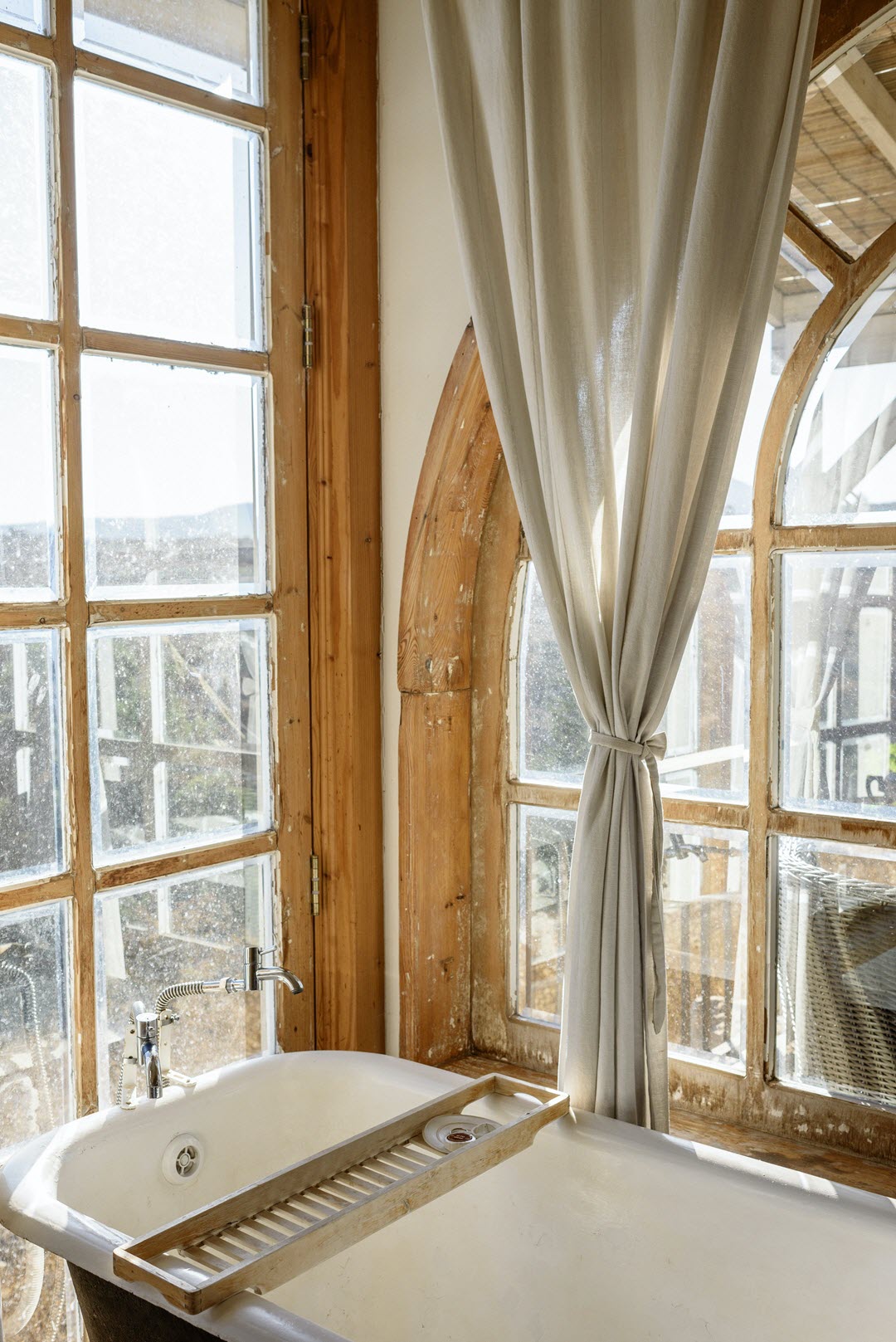
Texture
These next two elements are often confused. Texture and pattern are not the same thing. Texture is about how things feel, and that can also come from visual queues because our brains can interpret texture from what we see as well as what we touch.
One of the things I see in a lot of homes where the designer is trying to achieve a vintage look is an overuse of distressed textures. This has become more and more common as DIYers refinish thrifted furniture with chalk paint and techniques that are meant to make painted pieces appear old and used.
We’ve all seen this, right? A piece of furniture that’s been poorly refinished and just feels unnatural? And when every single piece of furniture in that same room has this same texture, it just doesn’t feel like a comfortable space. This is so overdone with folks who are trying to create a vintage farmhouse aesthetic, and now that I’ve pointed it out for you–I’m sorry, because you’re probably going to start noticing it everywhere.
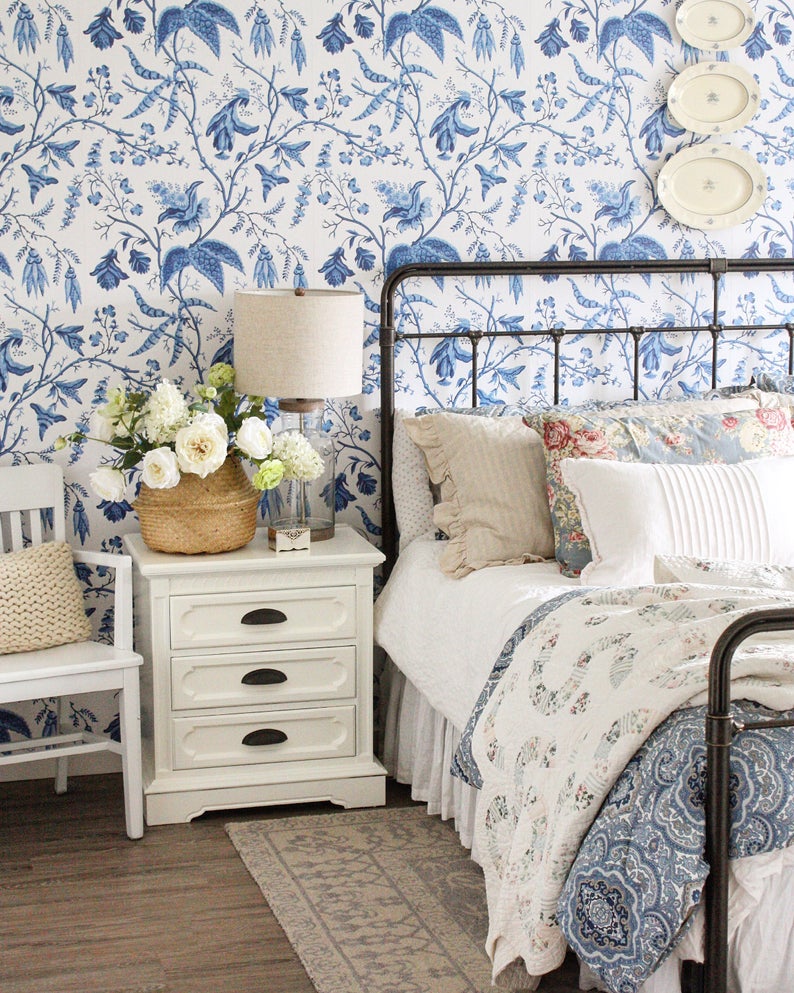 |
| Source | Shop More Like This |
Pattern
Not to be confused with texture, pattern is all about repetition. One of the obvious places where pattern comes into play is in wallpaper and fabrics, but other items in a room can also create patterns like gallery walls, light fixtures, and more. I’ll say it again–pattern is about repetition. (See what I did there?)
The important thing to remember is that pattern is about creating movement. When done well, it will add a great amount of visual interest to a space. But when patterns overwhelm, it can feel oppressive or chaotic.
In a vintage style home, wallpaper is such an easy way to incorporate feelings of the past. Today, you can even find peel-n-stick wallpaper in vintage patterns that’s so easy to apply! These are a few of my favorites (click any photo to shop):
My tip for those who want to use wallpaper to add pattern within a vintage design aesthetic would be to create an accent wall. Alternatively, you might try applying wall paper only on the part of the wall above the chair rail while keeping the area from the chair rail to the floor a neutral color.
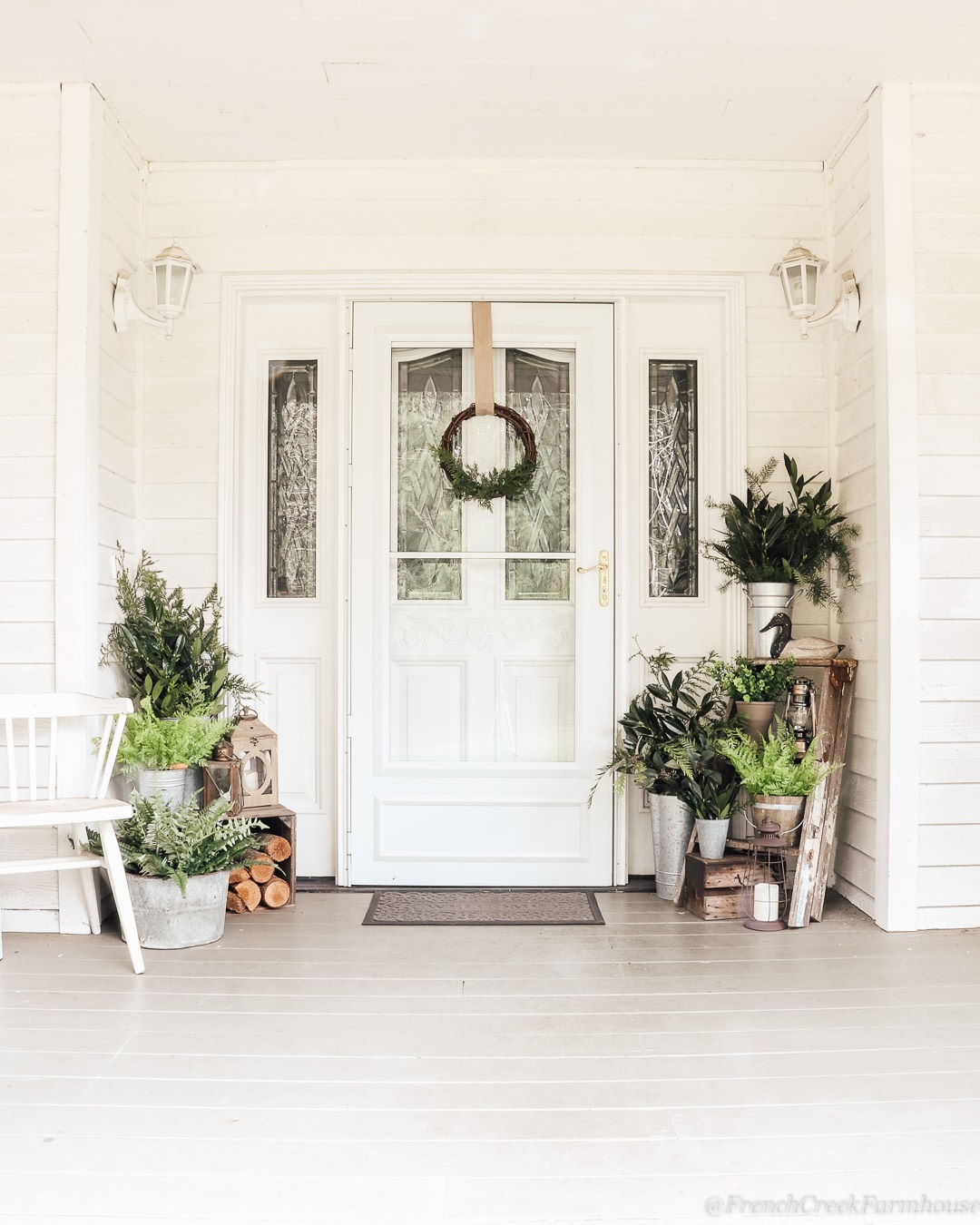
THE 5 PRINCIPLES OF DESIGN
By now, you should have a good understanding of the seven important design elements–those are what I like to think of as the ingredients in designing your space. Now, we’ll move on to discussing the five principles of design–these are the tools you’ll use to work with your ingredients.
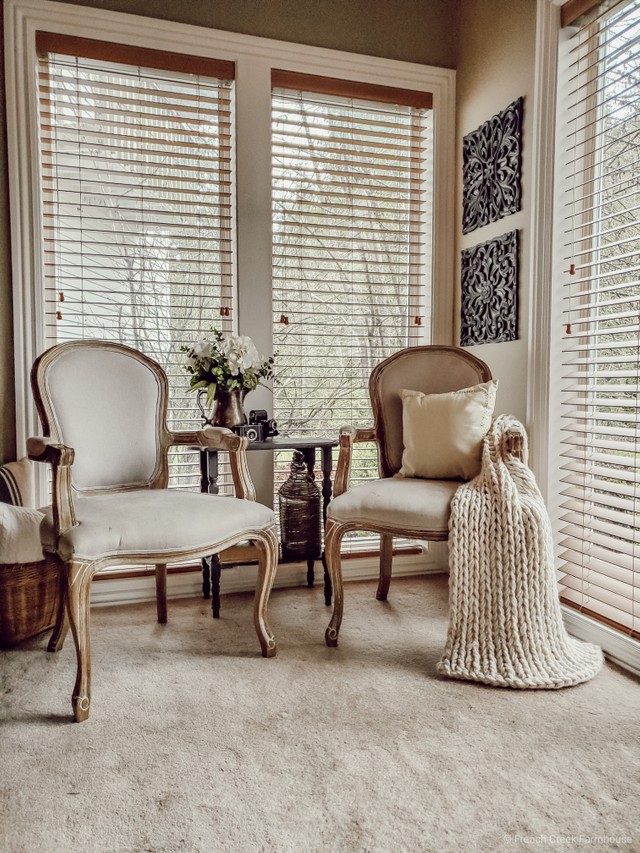
Proportion and Scale
These two concepts are similar, but have an important distinction. Scale is about the size of something in relation to a specific known size. For example, the scale of a mirror on a wall that’s 9′ tall by 15′ long.
Proportion, on the other hand, isn’t about a specific measurement per se. Instead, it’s about the relationship between objects, or groups of objects.
In the photo above, the proportion of the little vintage table to the two French style parlor chairs works well. But imagine that same small table beside a large sectional sofa. It wouldn’t feel right because the proportions would be off.
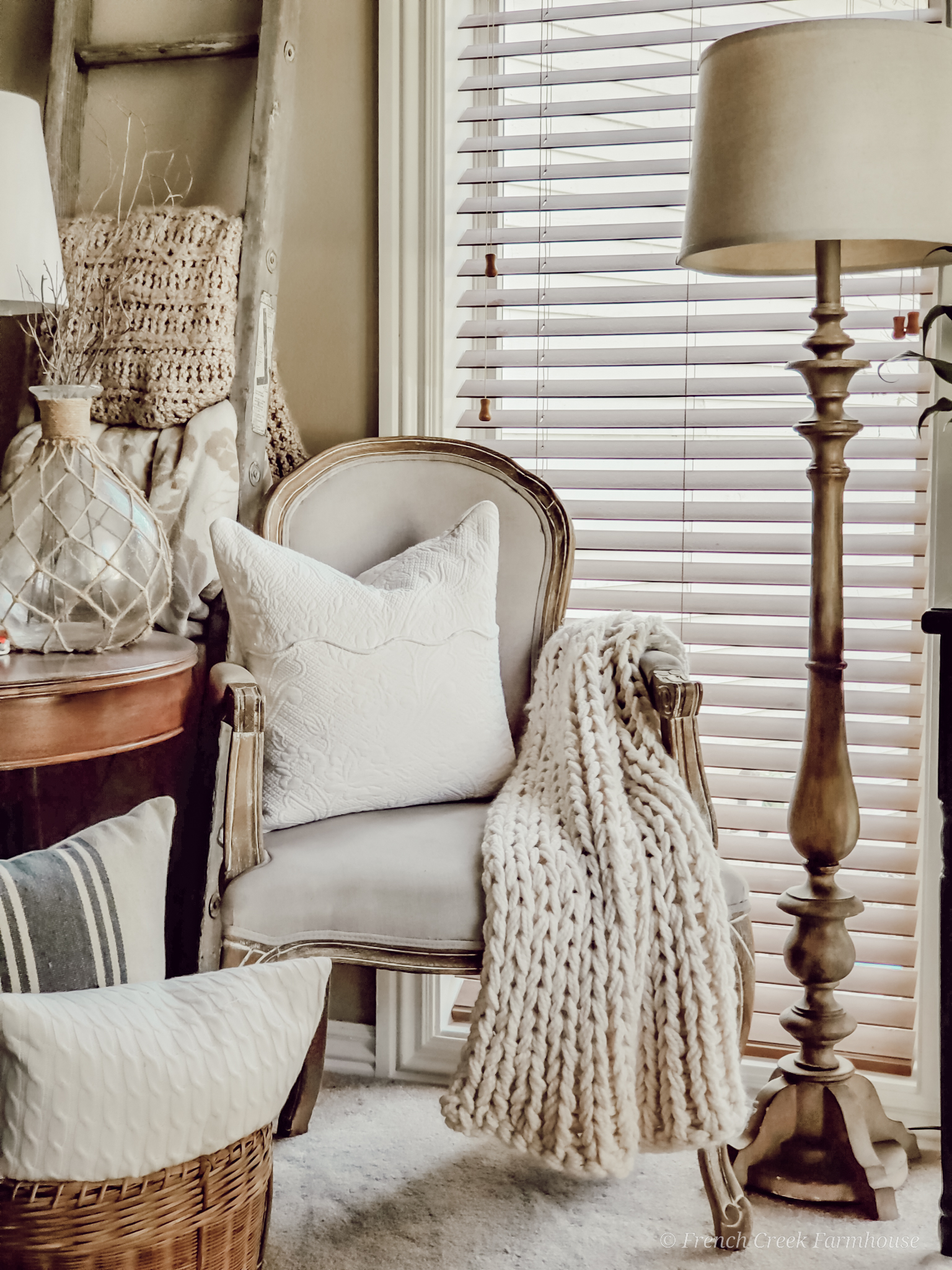
Balance
Balance can be broken into two categories: symmetrical or asymmetrical. You’ll use both in your designs, but you might find yourself drawn to one more often. Personally, my brain is soothed by symmetry.
Symmetry is achieved when both sides of the design are balanced with the exact same weight. Imagine a pair of shutters that flank a window. This type of balance gives the feelings of stability and tranquility.
Asymmetrical balance is achieved when the two sides, although different, still carry the same visual weight. This one is a bit tougher for new designers, but when you work with the concept enough, you’ll start to instinctively feel the visual weight of your designs.
The picture above is a great example of asymmetrical balance. Clearly, there’s no formal symmetry because these items are all different sizes, shapes, and colors. But the weight of the chair on the left, along with the basket of pillows balance the visual weight against the right side of the design with the tall floor lamp.
Just imagine this space, however, without the floor lamp. It would create an unsettling feeling of the visual weight tilting or sliding off to one side. That lamp helps to anchor the left side of the photo and balances the design.
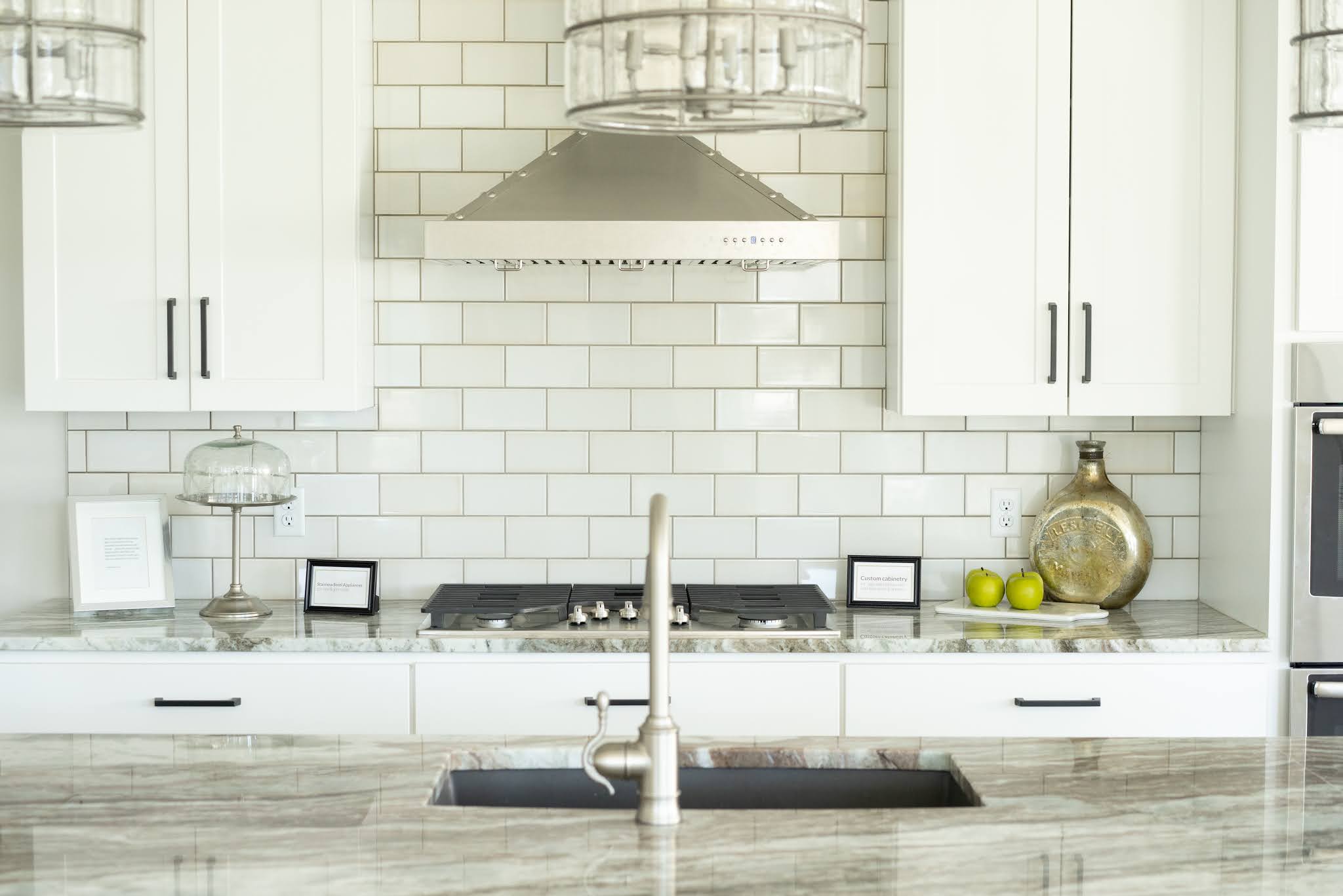
Rhythm and Repetition
Remember earlier when I said that objects, like a gallery wall or light fixtures, could help to create visual patterns? That’s due to repetition! Repetition creates pattern, and repeating patterns create rhythm.
Rhythm is what moves your eye, without you even being aware of it happening. It’s the visual tempo of your design, achieved through the repetition of patterns.
Imagine a building with a row of same-sized windows equal distance to each other. Or, the steps of a staircase. Or a subway tile backsplash. These all create visual rhythm.
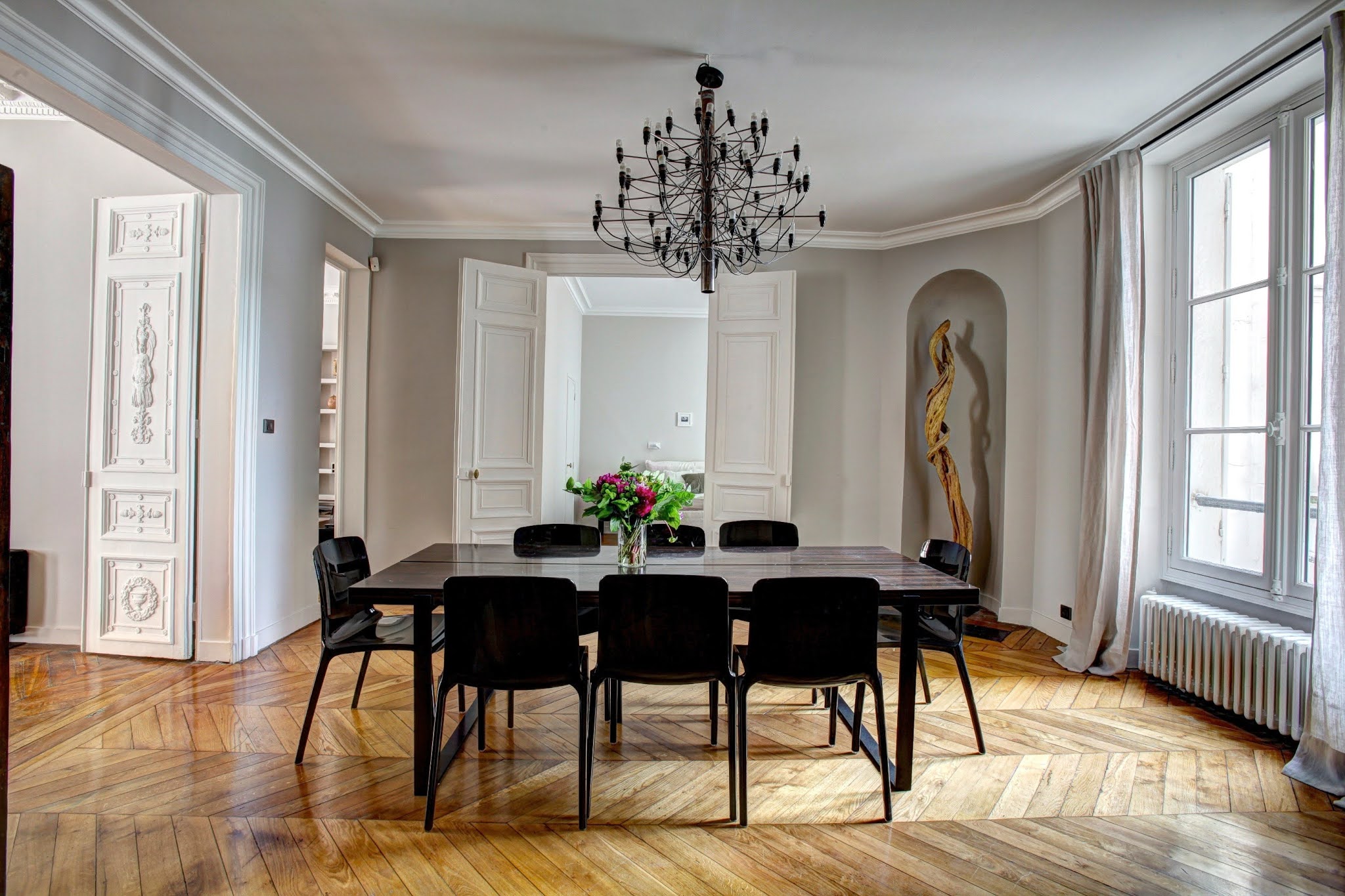
Emphasis
In whatever way you’re trying to design your room, what you’re really doing is storytelling. When you take a step back and look at the space, what is your room communicating? Where are you directing attention?
This is emphasis!
For example, in most people’s family rooms, the emphasis is often the television. The furniture is typically arranged around the position of the TV, as well as all other aspects of the room.
Not the story you want to tell? Then, you have to change the emphasis and design the room in a way that directs the eye to the important aspects that matter most to you.
In a large space, which is common in modern homes with open concept living, you can create multiple points of emphasis that help to define areas even where there are no walls or formal boundaries.
This is especially important when you want to style a vintage aesthetic room in an otherwise modern home. Older homes, which would be more “true” to the vintage style you’re working with, typically had closed off, designated spaces. You can still create this feeling, even in a modern home, as long as you pay attention to emphasis.
Just remember that every room needs to have a point of emphasis. Without it, the space will feel monotonous and uninspired.
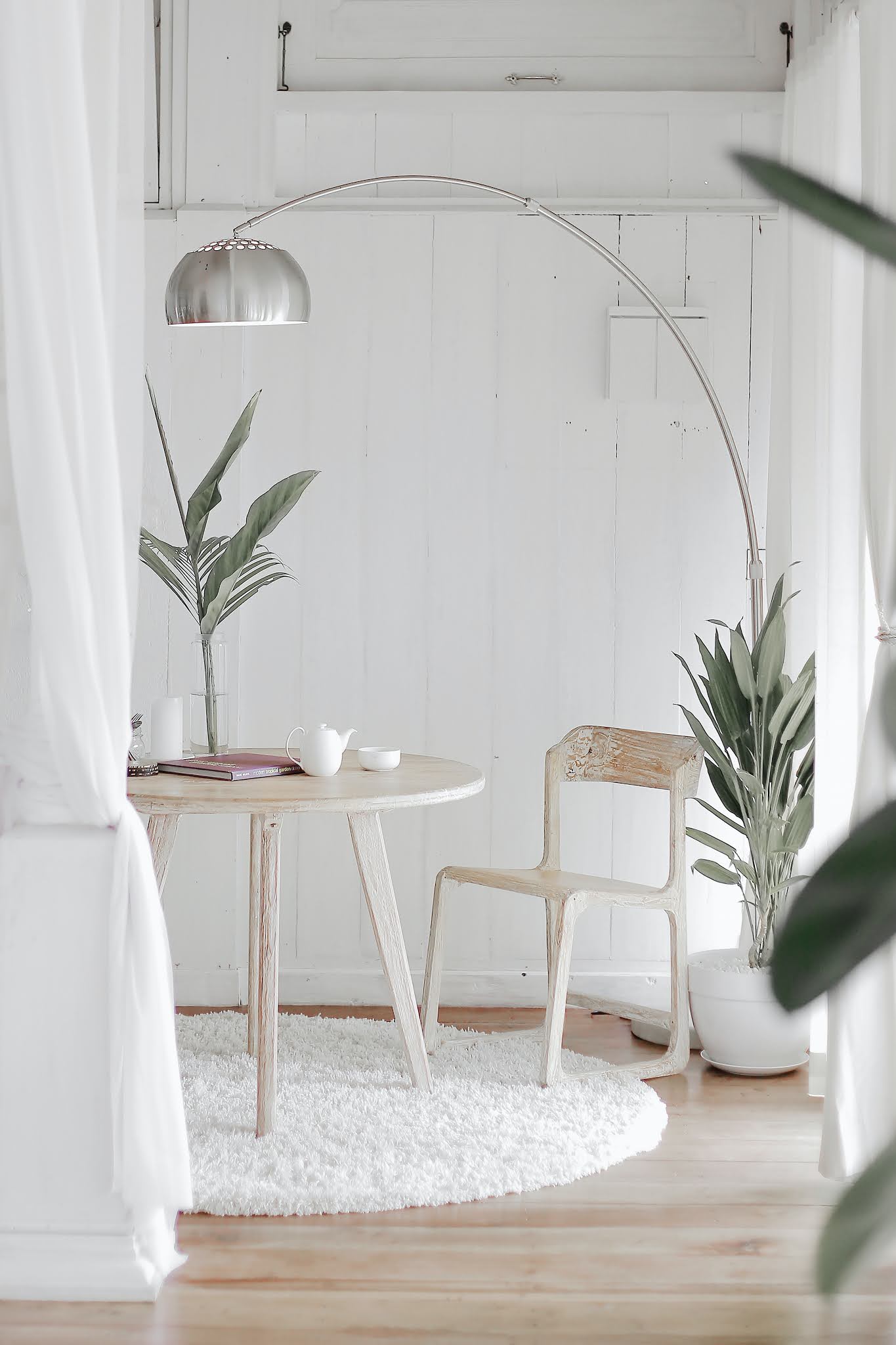
Harmony
Sometimes referred to as unity, harmony is the end result when all of the aspects of design are working together.
Now, I’m going to contradict myself here a little bit because earlier I said that you could choose different colors for the distinct spaces of your home. However, a common color palette is one of the simplest ways to create harmony throughout the home.
Does that mean you really should have the same color palette throughout your entire home? Absolutely not! It’s simply one option (and an easy one, at that) to achieve harmony in a design.
There are certainly other ways you can accomplish this with the vintage aesthetic. Perhaps, for example, you’re trying to stay true to a certain era, and so then you’ll want to make sure every space fits the category. You might also tie the different areas of your home together with the flooring, or even vintage fixtures. The possibilities are endless!
The important thing to remember about designing spaces you’ll love is that the “rules” of design should really be thought of as guidelines rather than formal mandates. It’s important to design your home in a way that creates a feeling of comfort and joy, and these guidelines can help you–but they shouldn’t ever restrict you from expressing yourself.
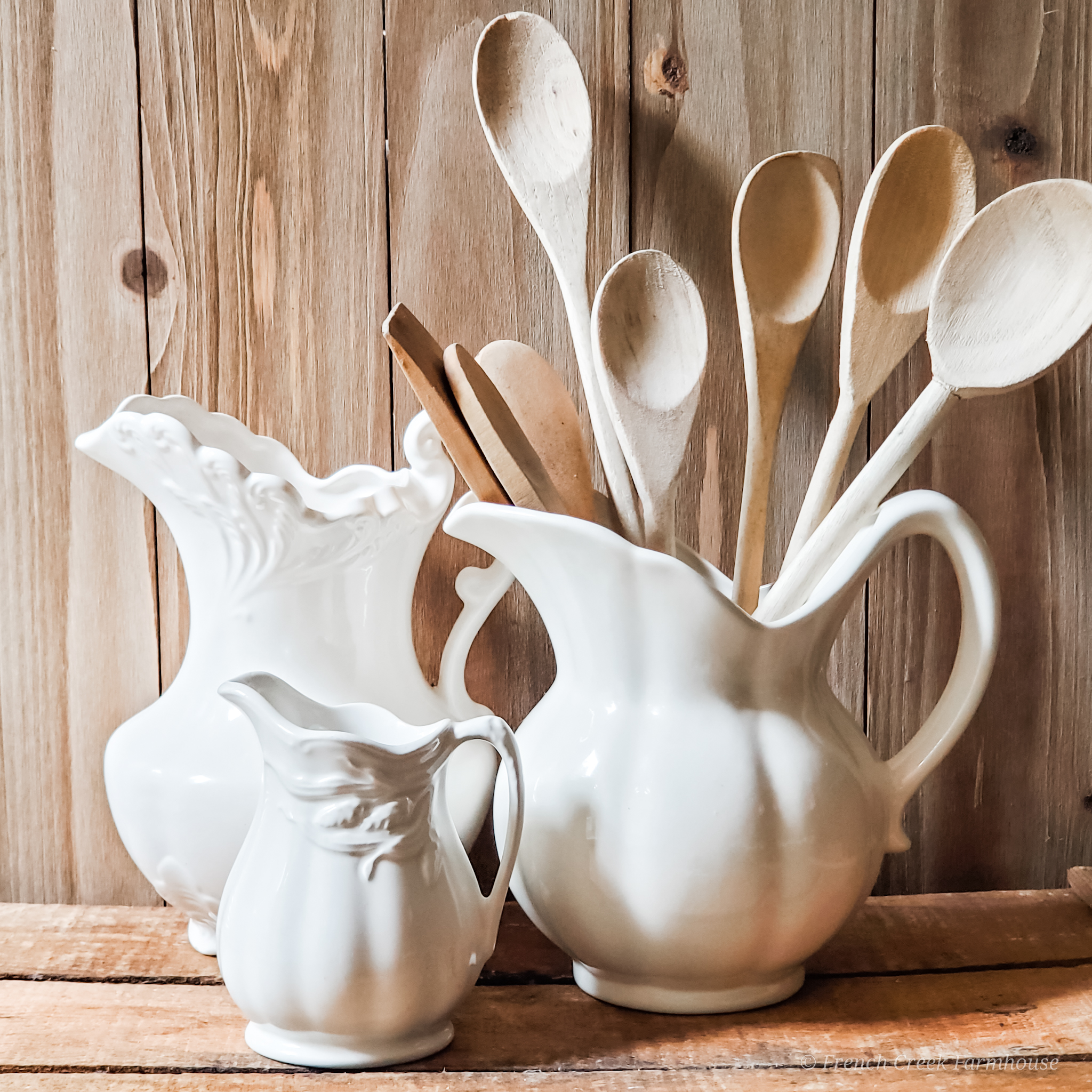
25 VINTAGE FARMHOUSE DESIGN ELEMENTS
As we’ve already talked about, vintage has a broad definition. You could design your home with a mid-century vibe, and it would be considered vintage. You could also go full-on shag carpeting and groovy 70s style, and that would still be vintage–although nowhere near the same design aesthetic.
In our home, I decorate with a vintage farmhouse style, and that’s simply what feels most cozy to me. If you’re into the same style (and I imagine that you probably are if you’re reading my blog!), you might wonder what types of items most exude the vintage farmhouse aesthetic.
The truth is, there are tons! But I’ve narrowed it down to the top 25 things that I am always keeping my eyes open for when I’m out scouring for vintage finds. If you find and incorporate these 25 items into your decor, you will be well on your way to creating a vintage aesthetic room!
And if you need more ideas, I frequently curate lists of my favorite vintage collections for you to get some inspiration.
Without further ado, and in no particular order…let’s go vintage hunting! I’ve included sources for each of the items I’m featuring–but a word of caution: If you see something you love in this list, be sure to snag it right away.
Most of the time, since these are vintage items, there’s only one available. Once it’s gone, it’s gone! To help, I’ve included links to additional similar items as the ones pictured, as well!
1. Architectural Salvage
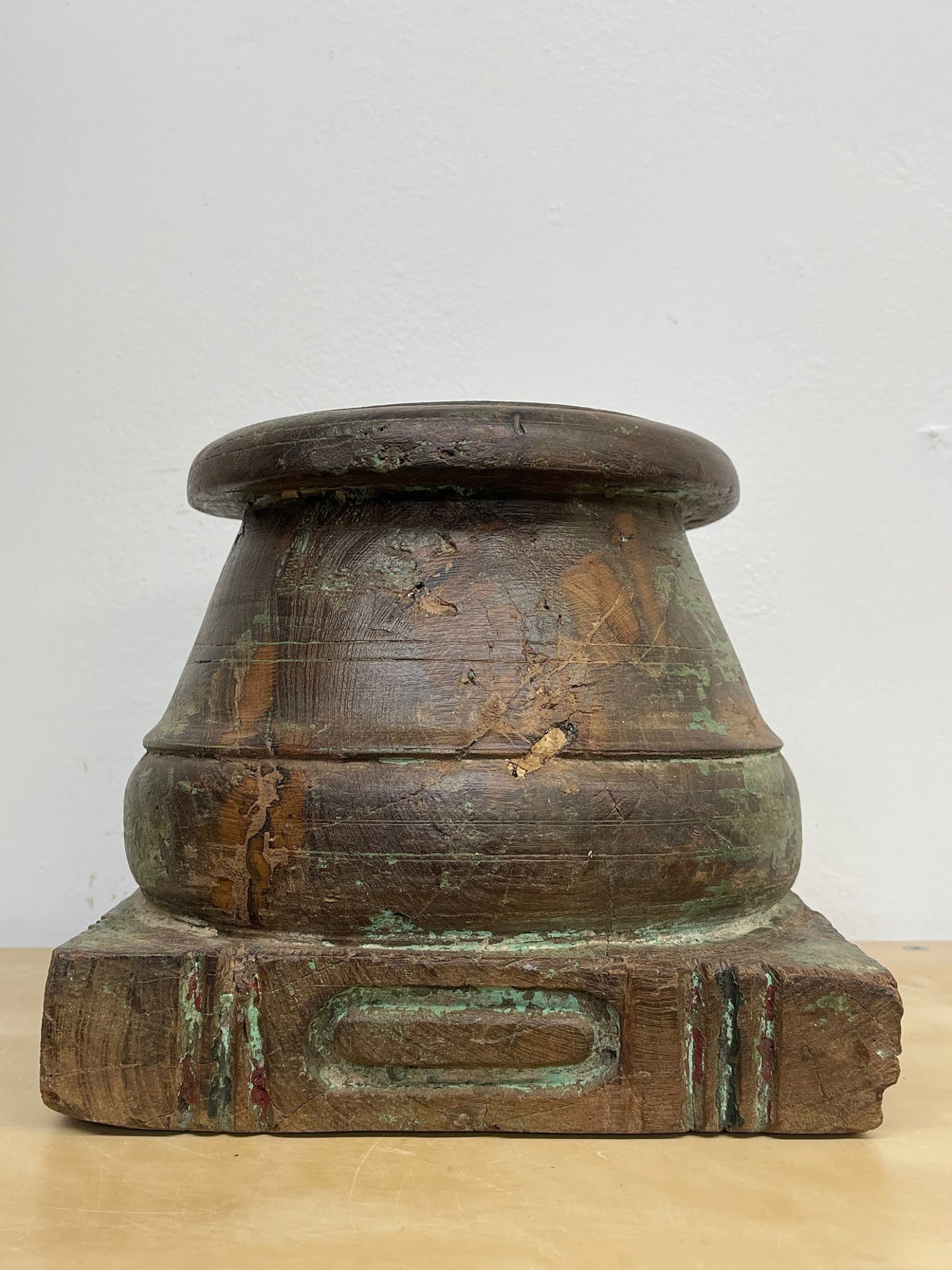 |
| Source | Shop More Like This |
Technically speaking, architectural salvage could be anything that was salvaged from…you guessed it…architecture. But what I’m talking about specifically here are the pieces of trim work and accessories that gave older buildings their character.
An old column base, like the one above, makes a charming pedestal to display a vignette of vintage treasures or a collection of candles. Other popular forms of architectural salvage in a vintage farmhouse are old window shutters, fireplace mantels, window and door lintels, and porch spindles (which make excellent blanket ladders!).
I love architectural salvage so much that I pin it (here) whenever I find a unique piece to inspire me. Maybe you’ll find some great ideas for yourself!
2. Corbels
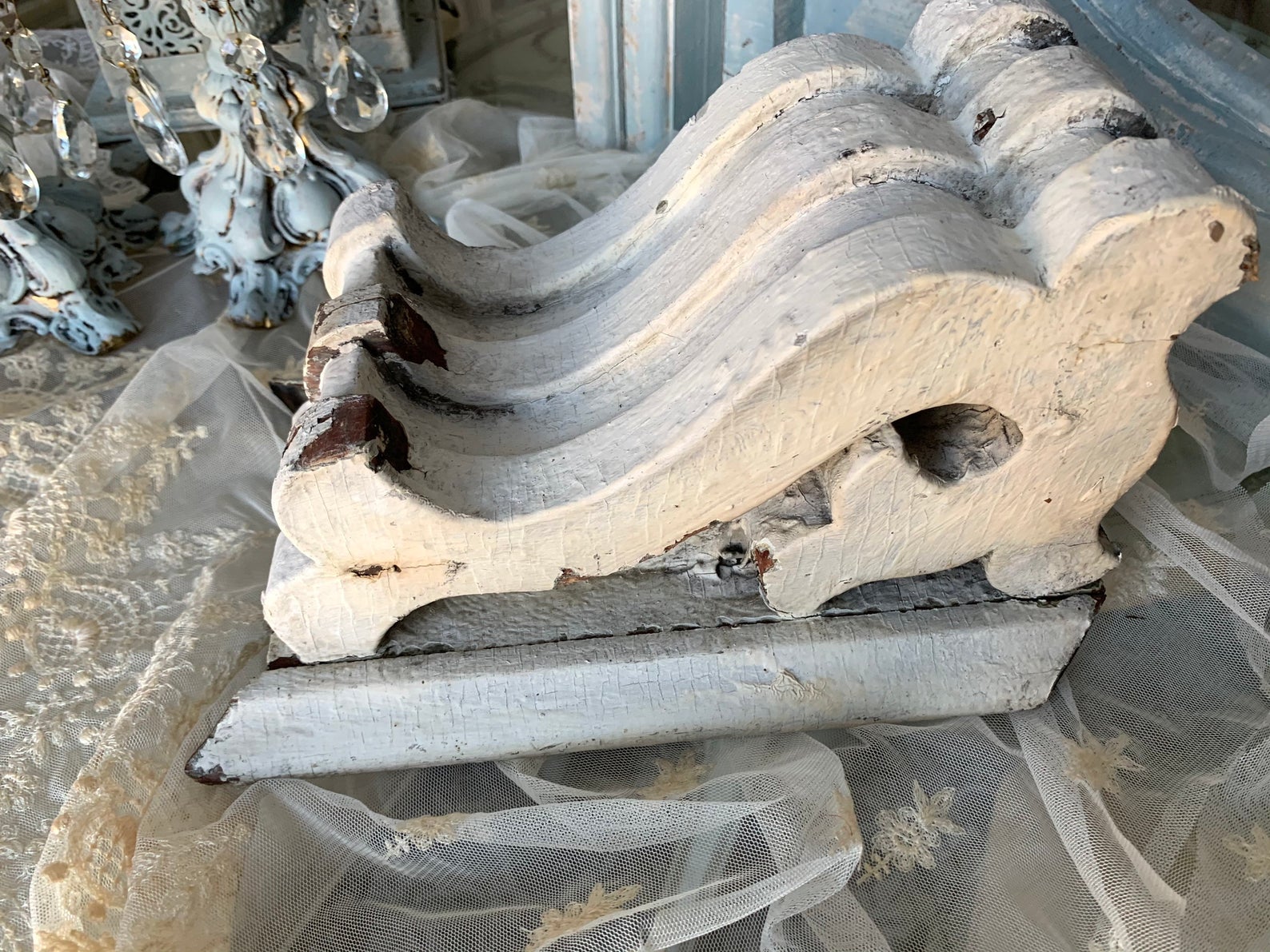 |
| Source | Shop More Like This |
Wait, aren’t corbels a type of architectural salvage? Why yes, they are, my keen friend! But they’re also so popular in a vintage farmhouse room that I felt they really deserved their own feature.
So, what are corbels anyway?
A corbel is basically a type of bracket, and the fancier the better in a vintage farmhouse! If you’re looking for decorating ideas and ways to use corbels, you’re in luck because I have an entire Pinterest board dedicated to them!
3. Flashcards
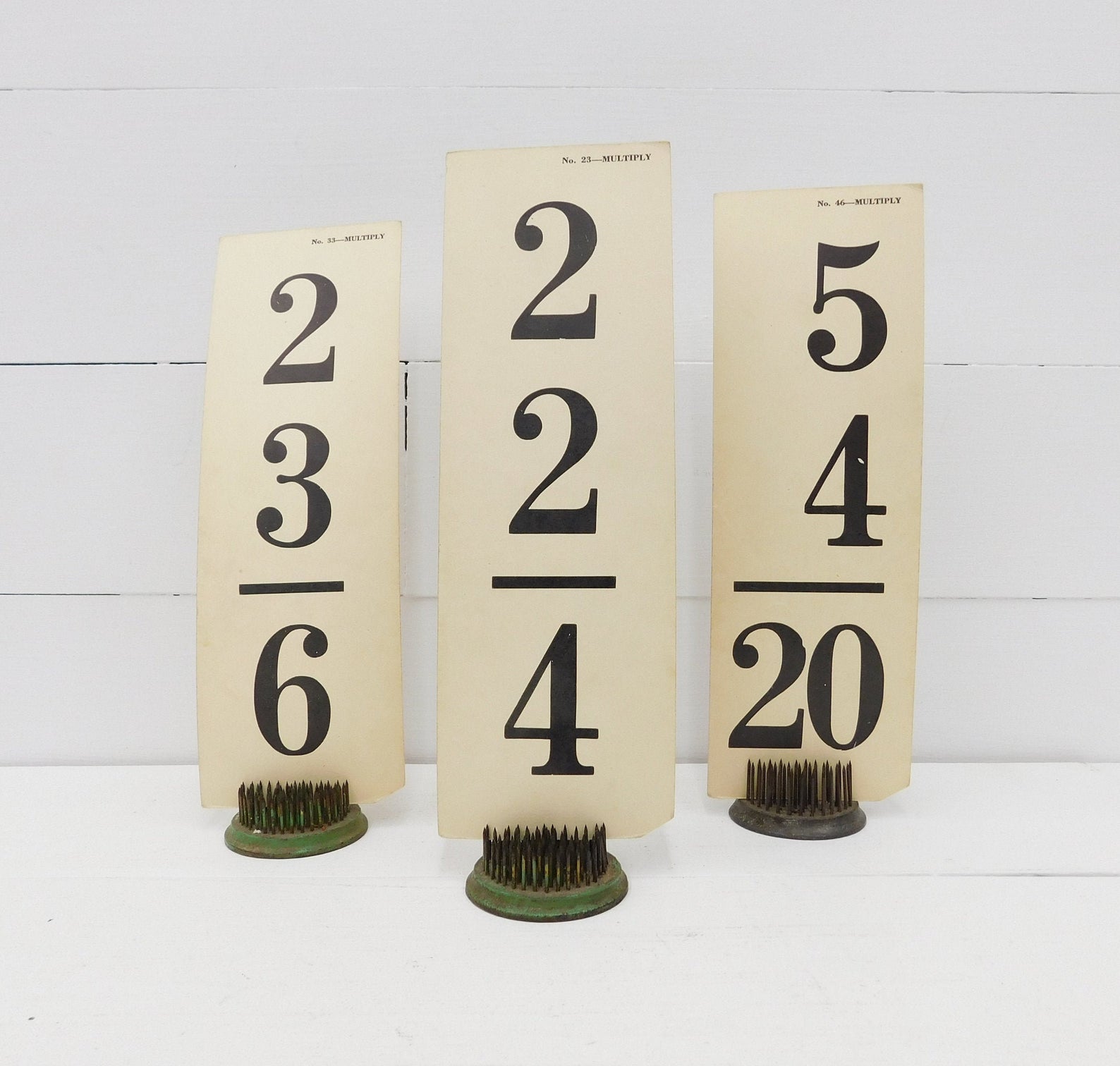 |
| Source | Shop More Like This |
If you’re like me, then you’re old enough to remember using flashcards for learning both reading and math when you were young. Even though you can still buy these for kids today, they have a more glossy and modern feel than the fantastic old vintage ones of the past.
They’re so popular in decorating, too. You can easily tuck them into a shelf, like I did all the way up in the first pic at the top of this post.
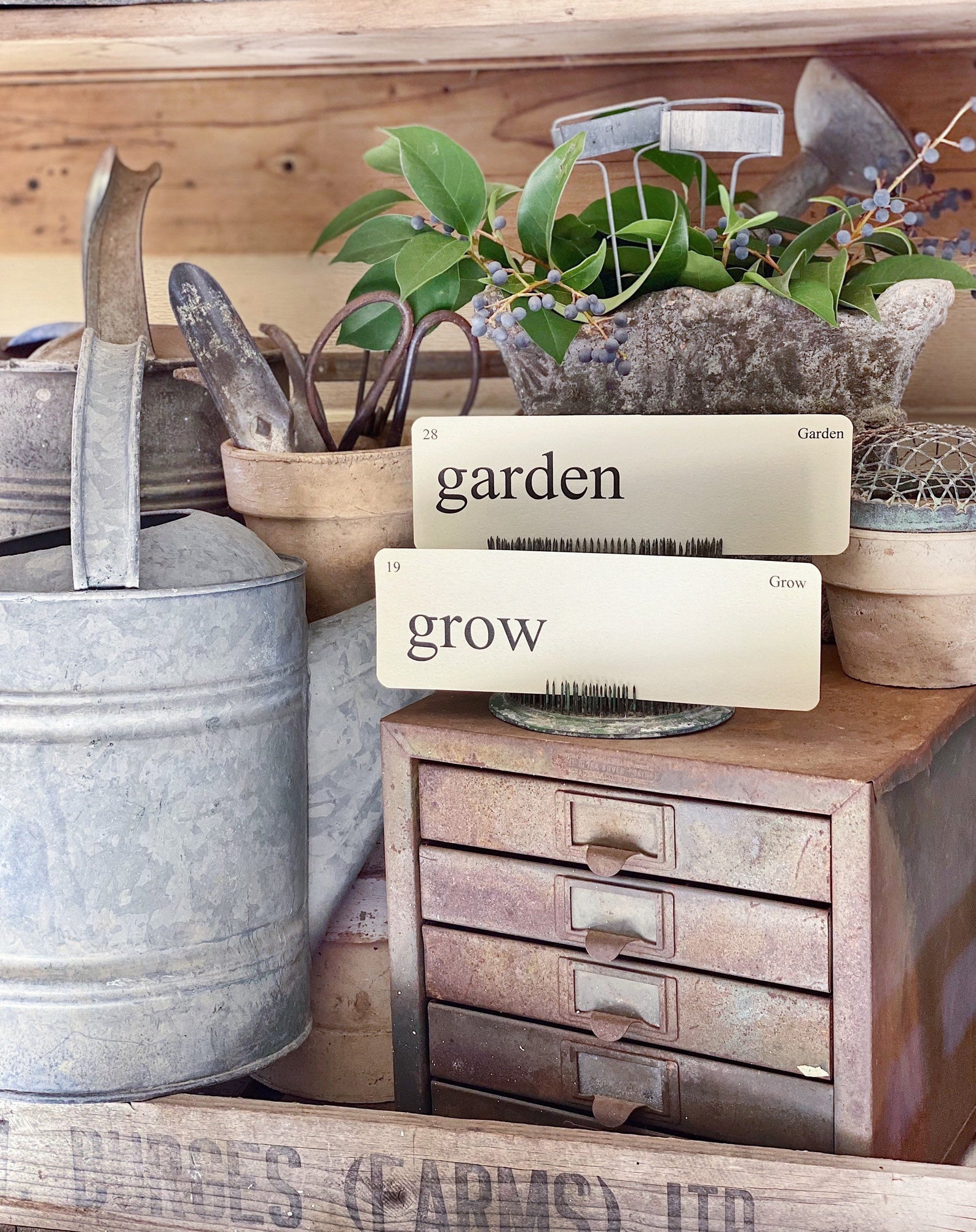 |
| Source | Shop More Like This |
You can also find a wide variety of reproduction flashcards that are made to look vintage and come in an array of themes. I love these garden-themed cards for spring or summertime!
Vintage floral frogs are an easy way to display flashcards with an added vintage touch, as well. Frogs are just weighted bases with sharp tines that you place into the bottom of a vase to hold your flower stems in place when creating an arrangement. But their tines make it easy to display photos and other paper ephemera as well!
4. Scales
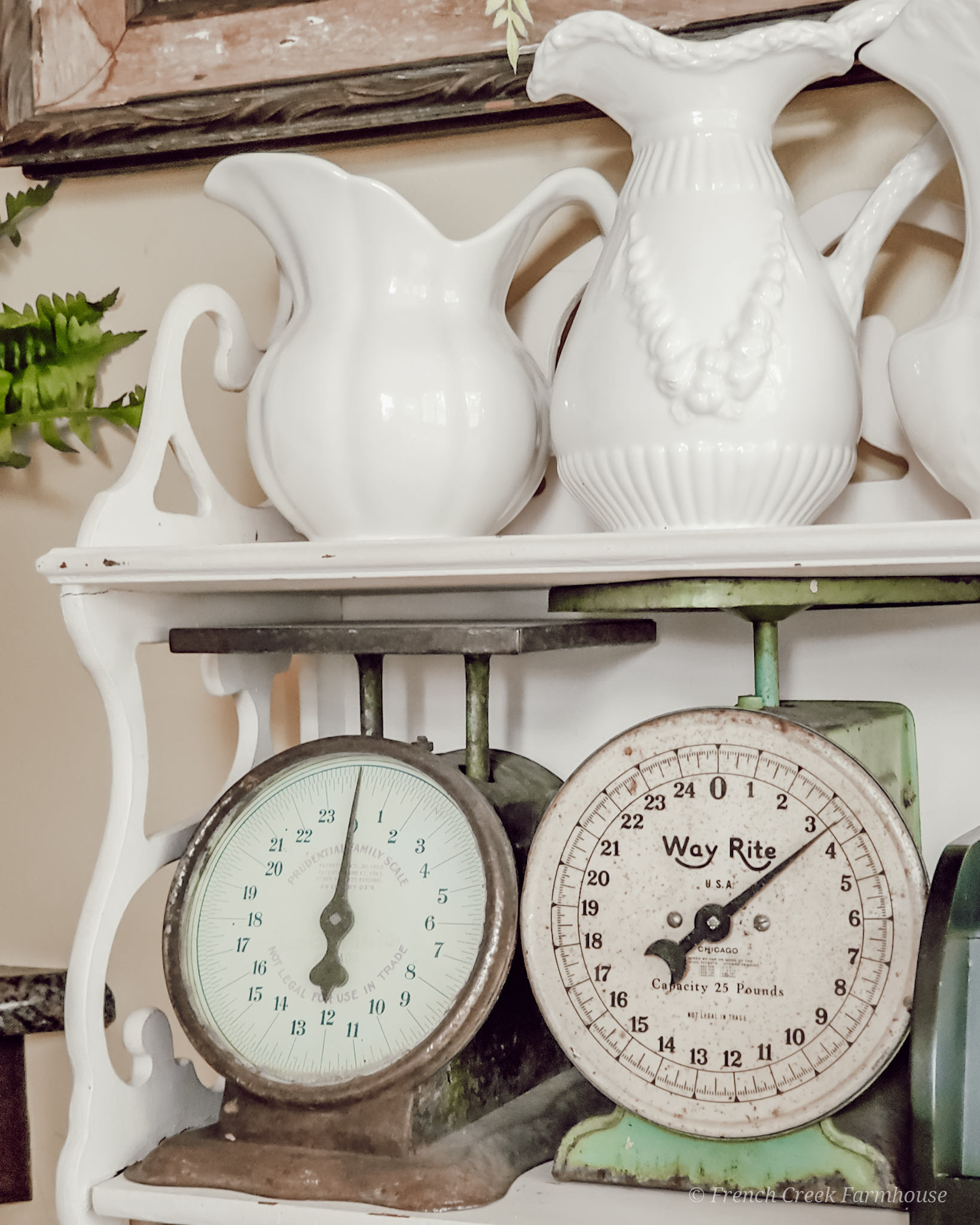 |
| Shop More Like This |
I adore old vintage scales of every kind. Last year, on the one and only vintage hunting trip I made before the entire world shut down due the pandemic, I found an amazing antique candy scale in a vintage shop. I only paid $20 for it, but I later did some research about it and found out it was worth over 10 times that! Needless to say, I will cherish that find forever!
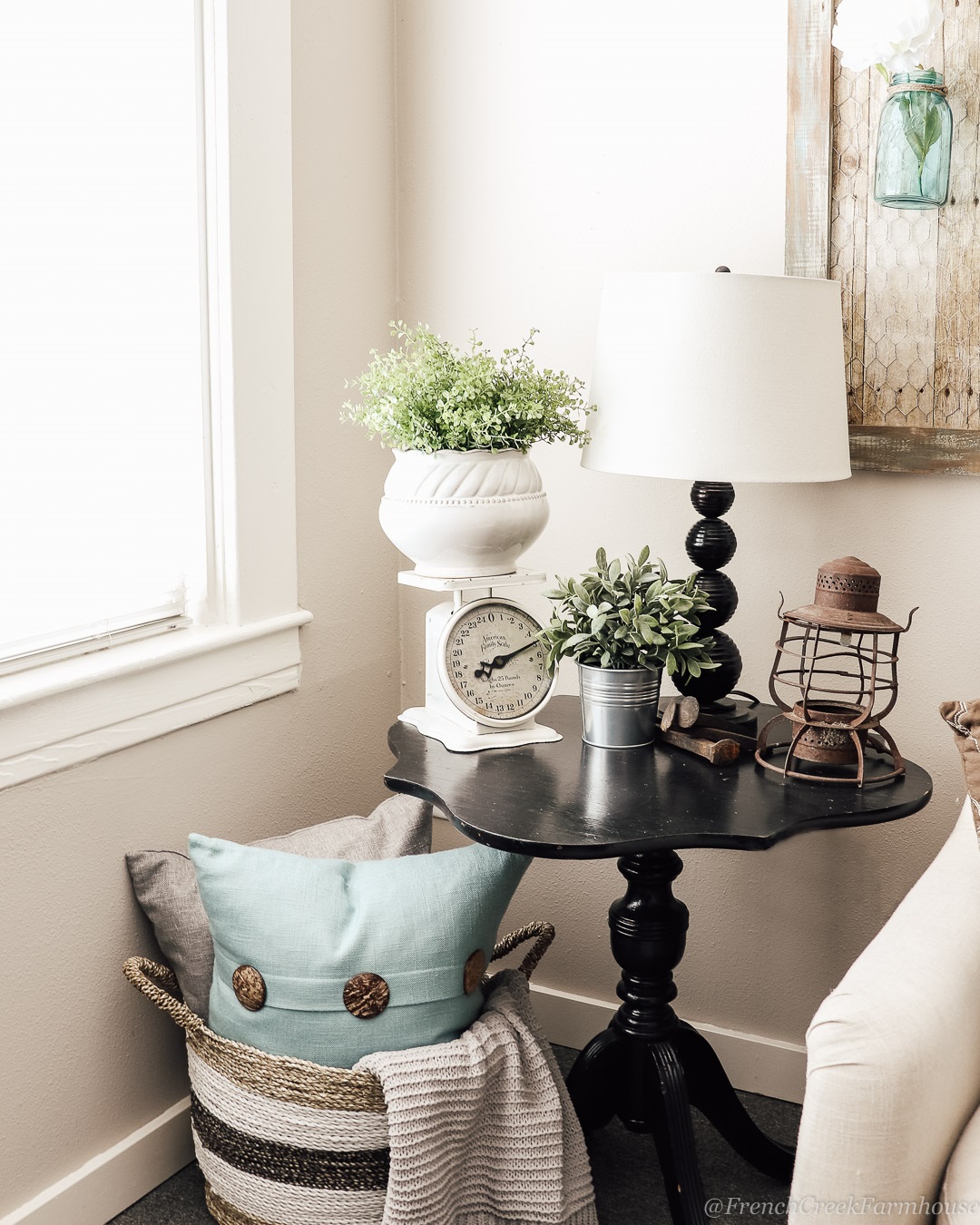 |
| Shop More Scales |
I also love old rusty kitchen scales, and we have several of them scattered around our home. I like to use them to display my potted plants because, if they’re still in working order, it’s an easy way to know when my plants need water. I can literally see the weight decrease as the plant’s soil dries out!
Hanging scales could be used for trailing plants as well, and that’s something I hope to add to my collection in the near future!
5. Watering Cans
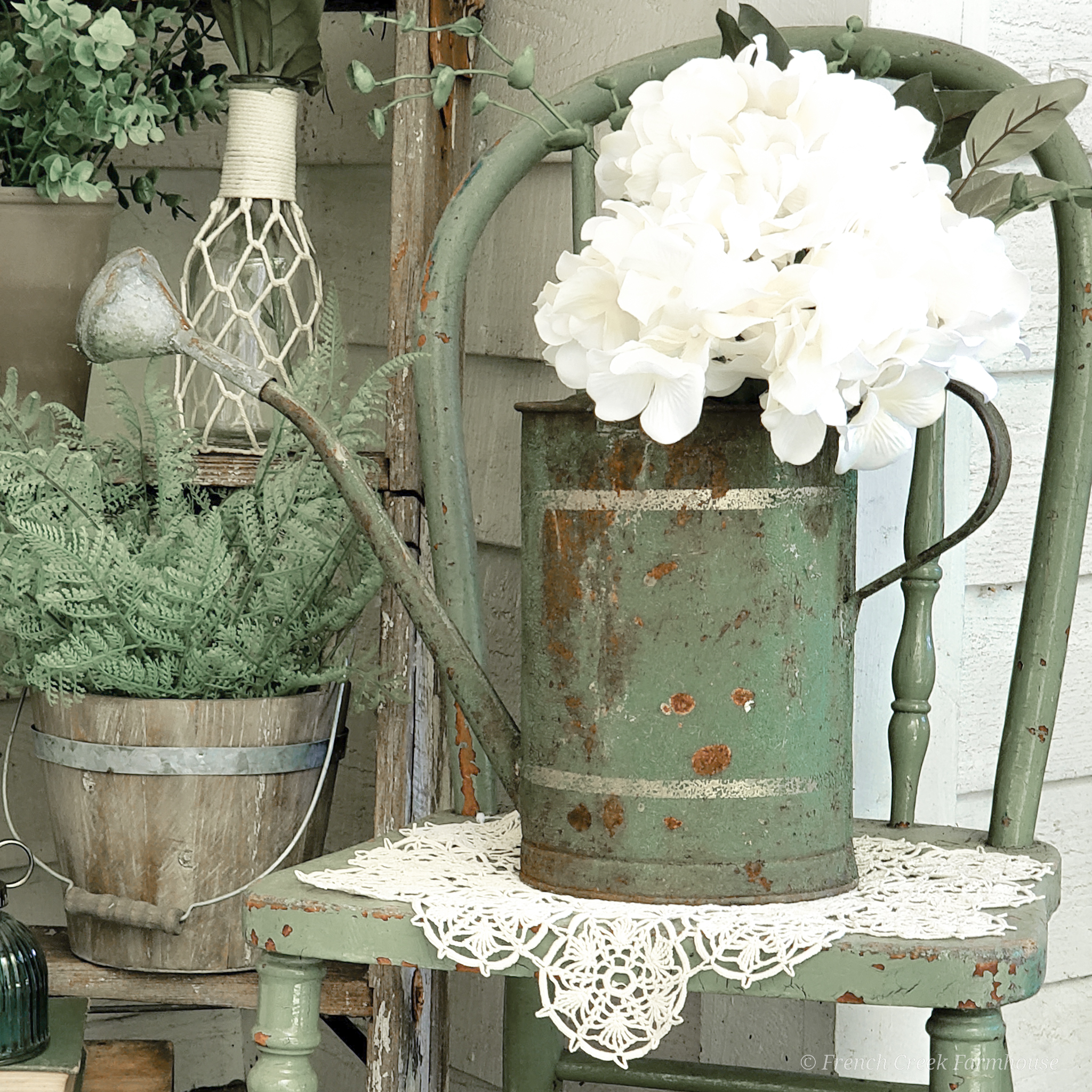 |
| Shop More Like This |
Oh how I adore old watering cans! Someday, I dream of building a beautiful English greenhouse on our little farm, and I envision decorating with my collection of rusty vintage watering cans. Until then, I’ll just keep hunting for more of the sweetest ones…
6. Breadboxes
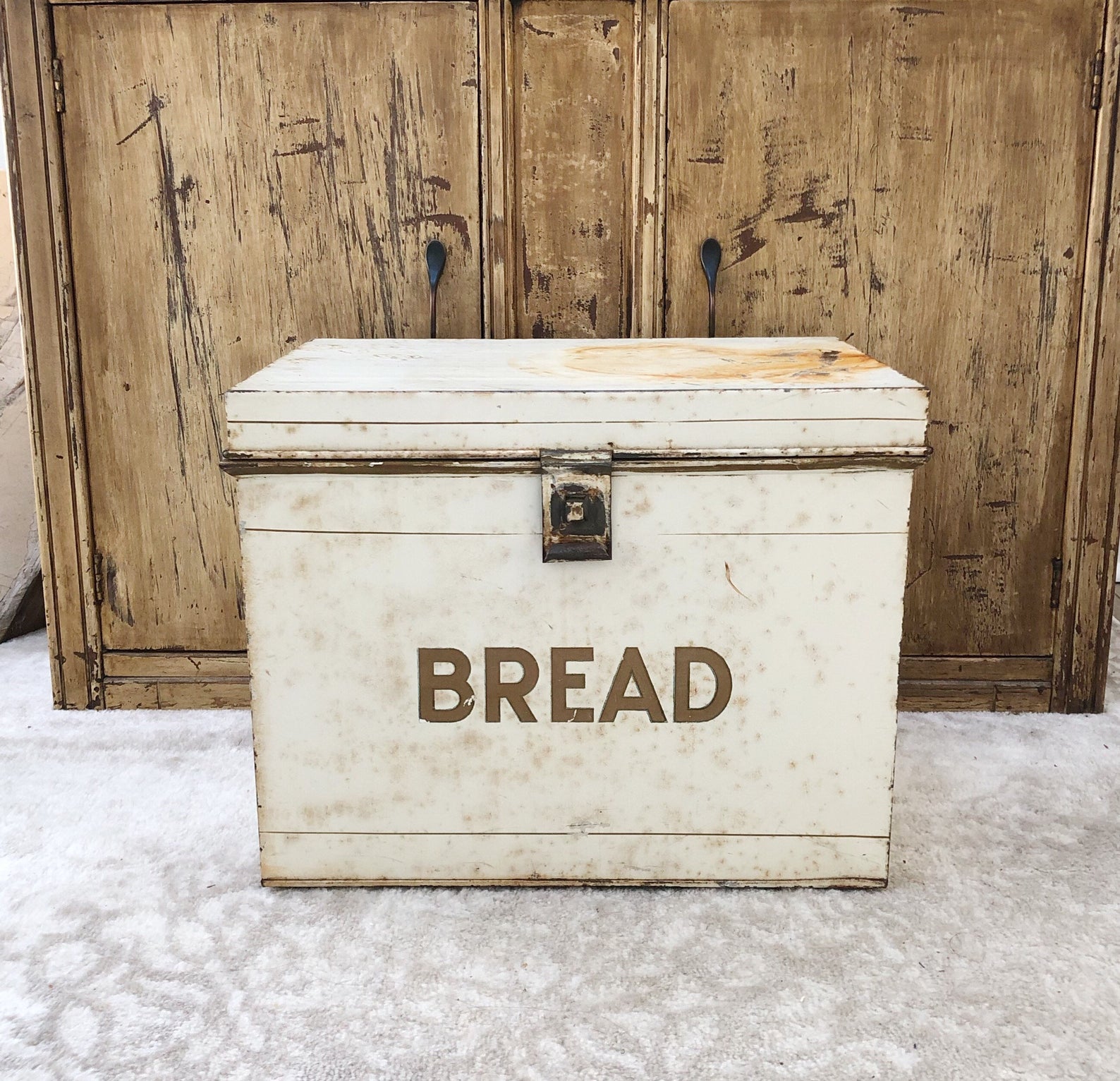 |
| Source | Shop More Like This |
Before commercial bread was loaded with preservatives and wrapped in plastic bags, people actually used to bake their own bread. I know! Gasp!
Breadboxes (or bread bins, if you’re reading this from across the pond) offer the ideal storage environment to prevent bread from getting moldy by keeping bread at a consistent room temperature, having a loose fitting lid that allows airflow to prevent condensation (and thus, mold) from forming, and protecting the bread from household pests.
A beautiful vintage breadbox is becoming more and more rare, but if you’re lucky to find one, you have a terrific treasure! If you’re looking for a breadbox that’s reminiscent of the past while you search for the perfect vintage find, we carry this one in our shop, and it’s definitely a best seller!
7. Seltzer Bottles
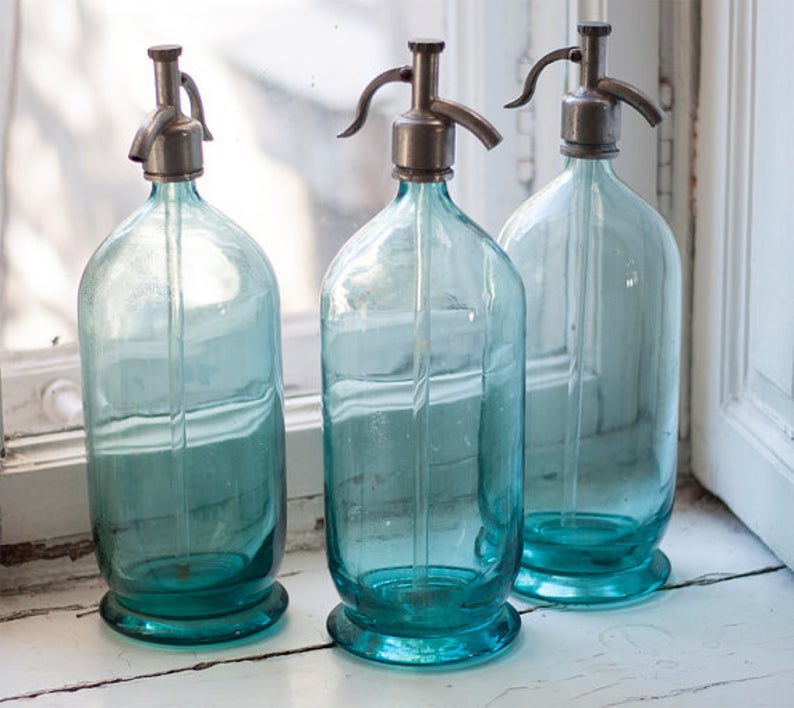 |
| Source | Shop More Like This |
Seltzer bottles, also known as soda siphons, first originated in France in the late 1700s and serve as a way to dispense carbonated water. These bottles reached the height of popularity between 1920-1930, but when the vast majority of seltzer bottle manufacturing plants were destroyed during WWII in Europe, they dwindled during the post-war era.
Today, finding a vintage bottle in good condition is a real treat! These always sell out immediately whenever I find a batch to add to our shop. You can expect to pay $45-60 for a traditional glass seltzer bottle these days, while the more rare bottles (like those with colored glass) will fetch hundreds.
8. Trophy Cups
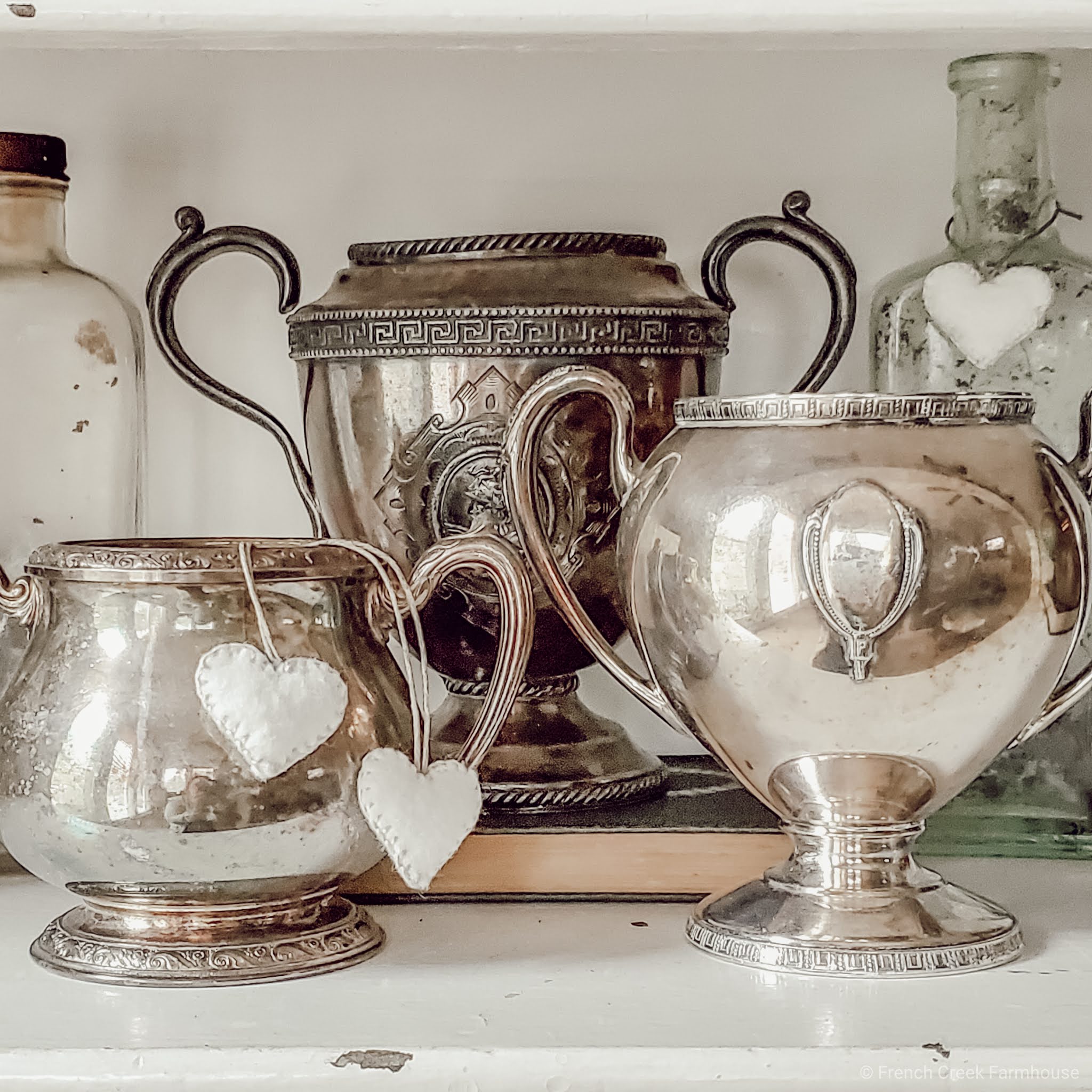 |
| Shop More Like This |
There’s something so special about awards for personal achievements that have happened throughout history. For me, I like to think about the pride and happiness someone felt when they received their trophy, no matter what the accomplishment might have been. These relics truly represent joy!
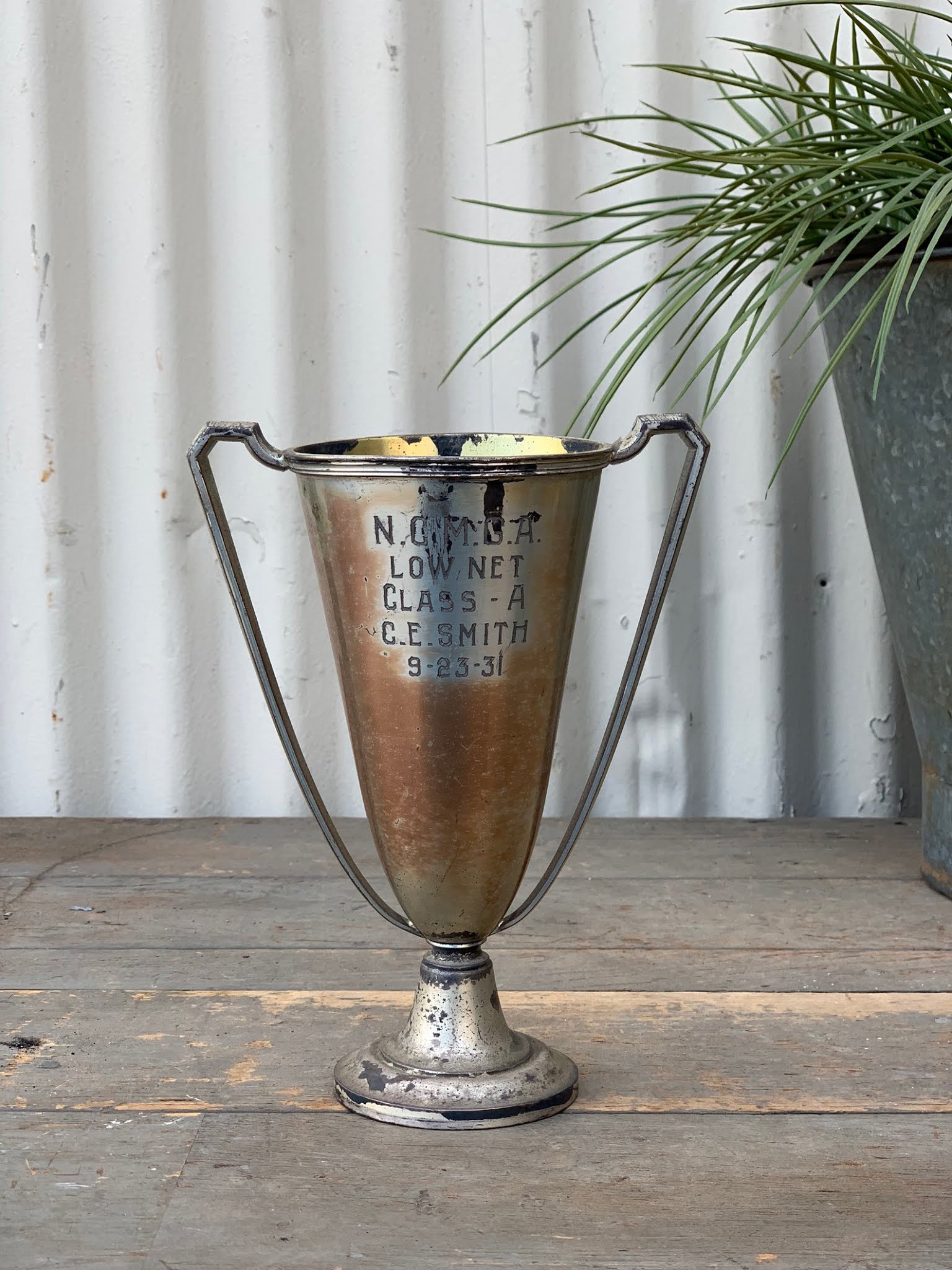 |
| Source | Shop More Like This |
There are so many types of trophies, but certainly loving cup trophies are the most well known. These two-handled cups were originally designed to be shared drinking vessels used in European marriage ceremonies, but later were popularly gifted as trophies for a variety of contests. In French, they’re called coupe de mariage.
9. Ironstone Pitchers
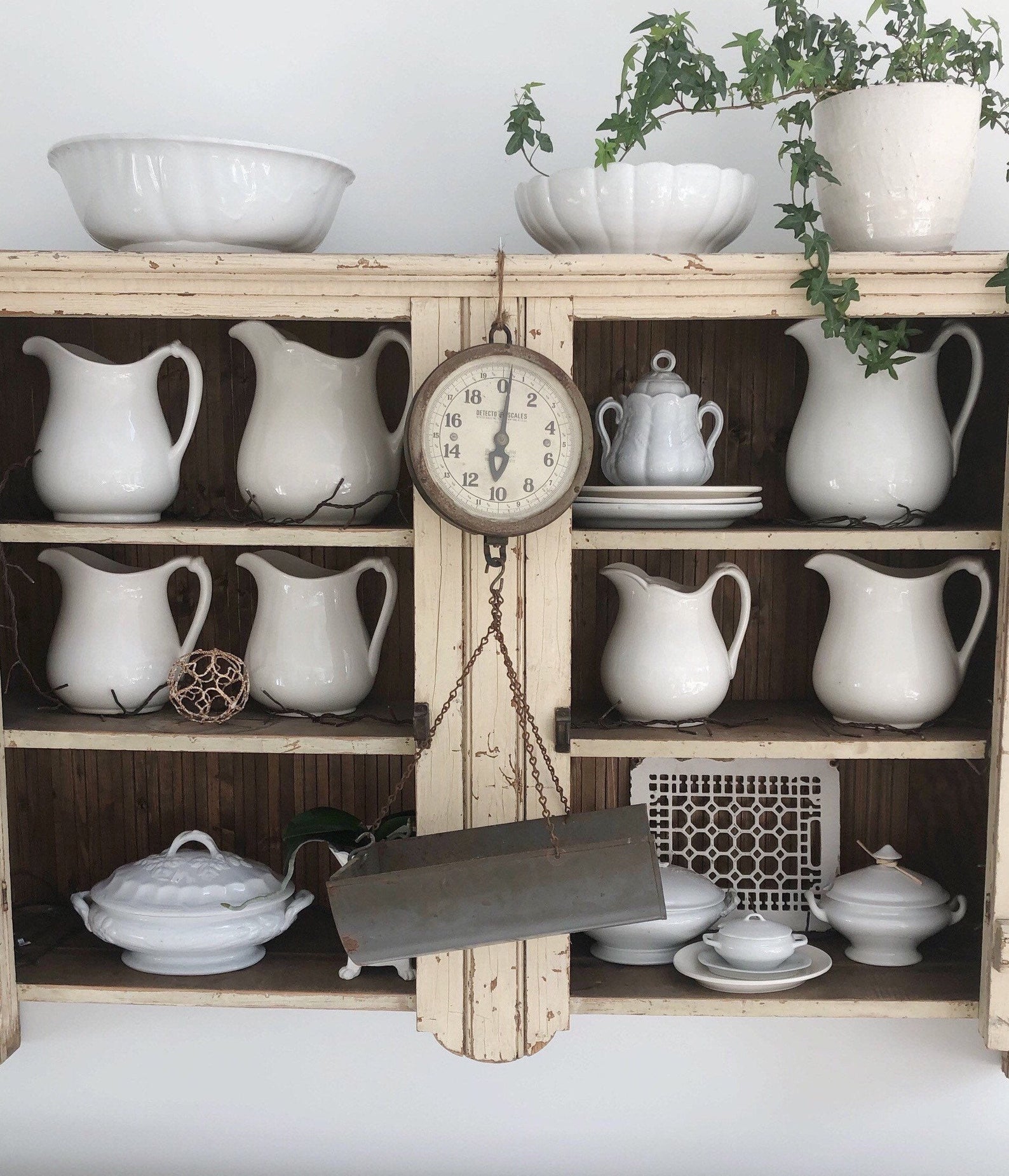 |
| Source | Shop More Like This |
The popularity of ironstone has risen significantly in recent years as neutral color palettes and farmhouse decor has become such a big trend. But, not all white pottery is ironstone (despite what you’ll see on Instagram almost daily).
Contrary to its name, ironstone contains no iron. It’s simply the name of a type of vitreous pottery called earthenware that became popular in Britain during the 19th century due to its strength and durability. The most collectible and valuable pieces of ironstone pottery were made by Mason’s (and appropriately named Mason ware) beginning 1813 after Charles James Mason patented the process.
10. Stoneware Jam Jars
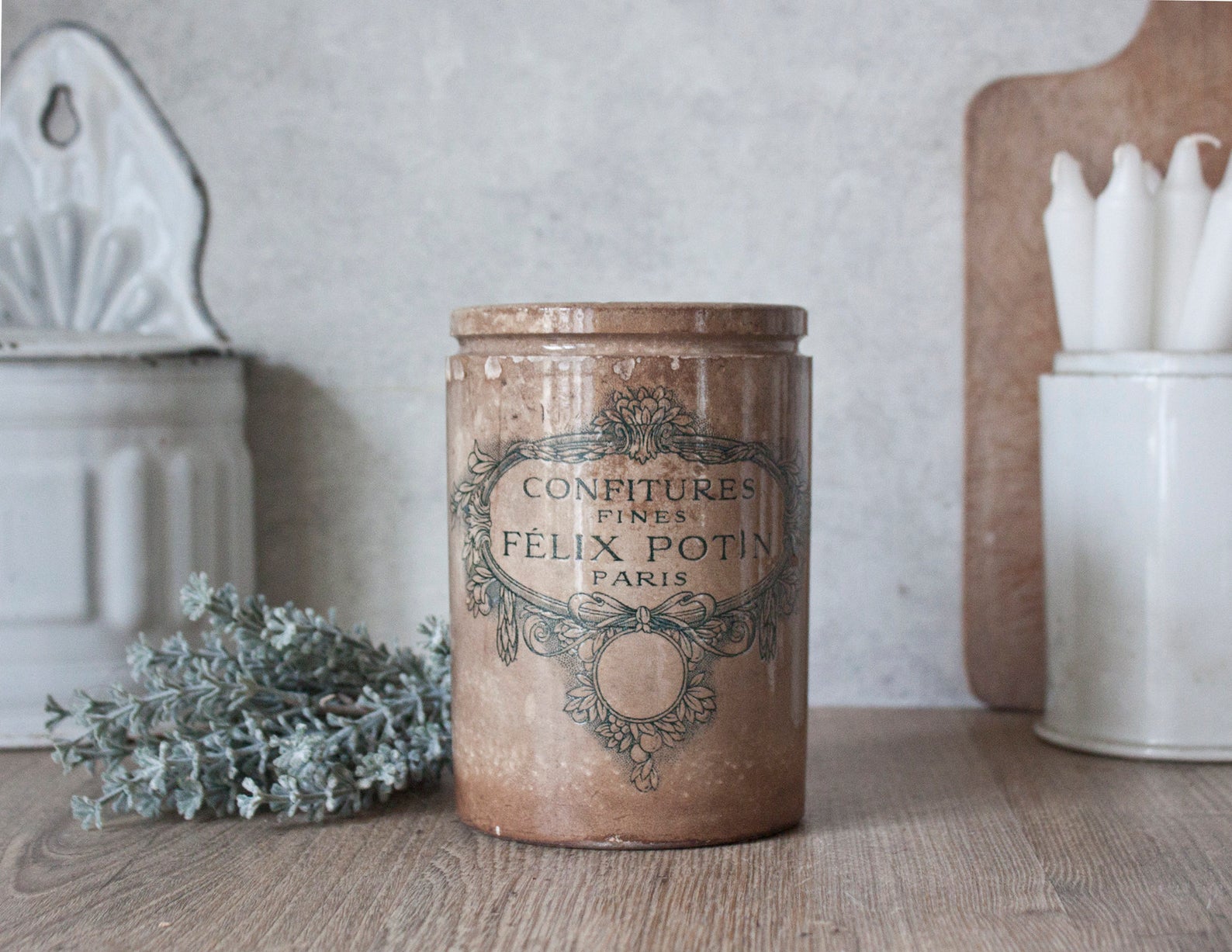 |
| Source | Shop More Like This |
I have only seen these really take off in popularity the past 2-3 years or so, and my guess it that they’ll only become more popular as they become a staple in vintage farmhouse decor. The most common type of these stoneware jam jars are the Dundee Marmalade jars. The Scottish city of Dundee started making orange marmalade in 1797, and the jam was sold in stoneware pots with a distinctive logo.
For Dundee jars, you can expect to pay $50-75 (at the time of this writing) per jar, depending on the size and condition. But I’m more keen on the French jam jars like the one in the photo above. These will fetch a much higher price, simply because they’re more rare. Remember, France was heavily bombed during WWII, so many of these relics did not survive the era. Finding one is a precious thing!
11. Bread Boards
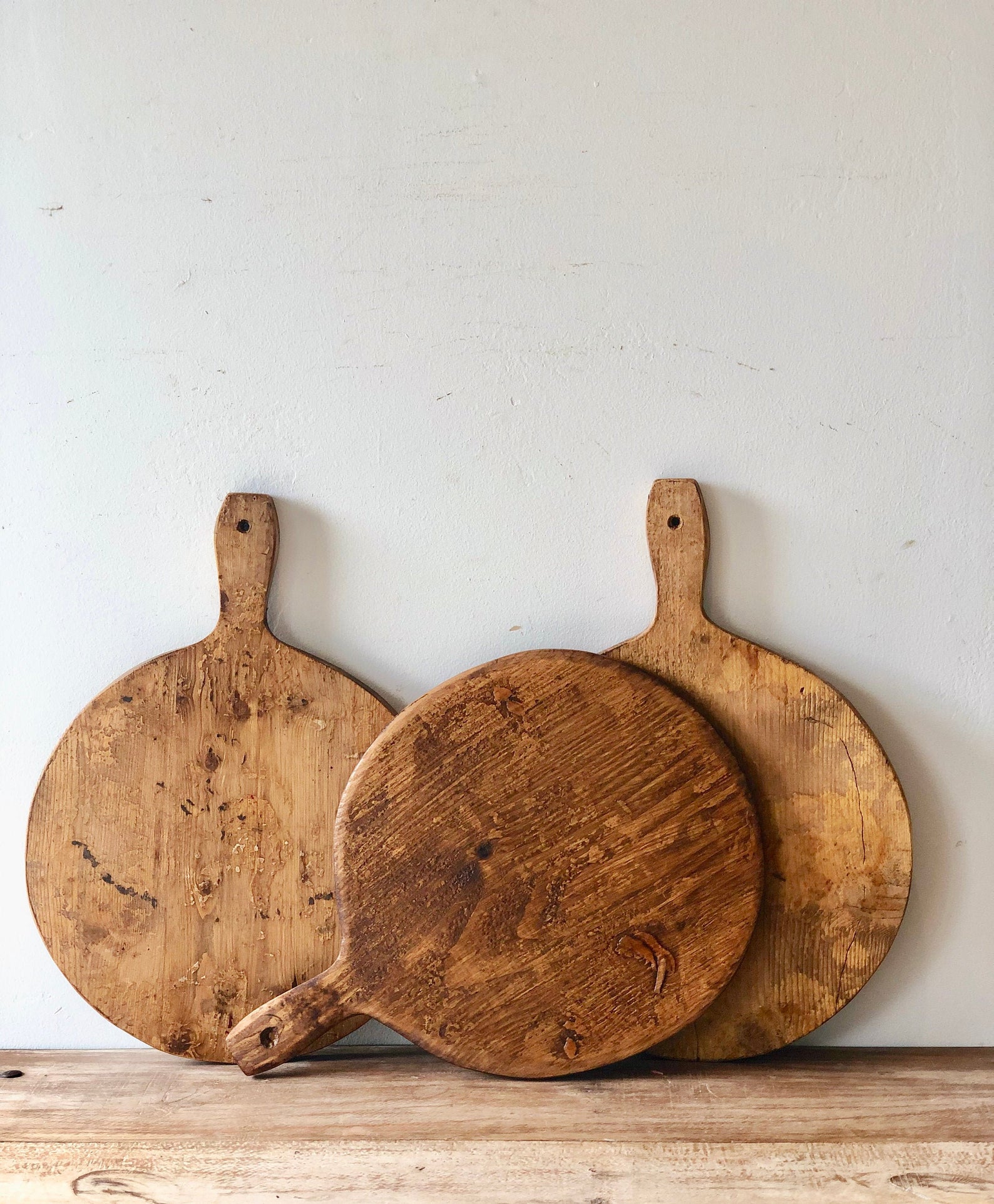 |
| Source | Shop More Like This |
Particularly if you like a more rustic, French farmhouse feeling, bread boards are going to be a fundamental piece of decor in your vintage farmhouse design. A collection of differing sizes and style boards looks equally stunning leaning above a fireplace mantel or hung on a kitchen wall.
12. Rolling Pins
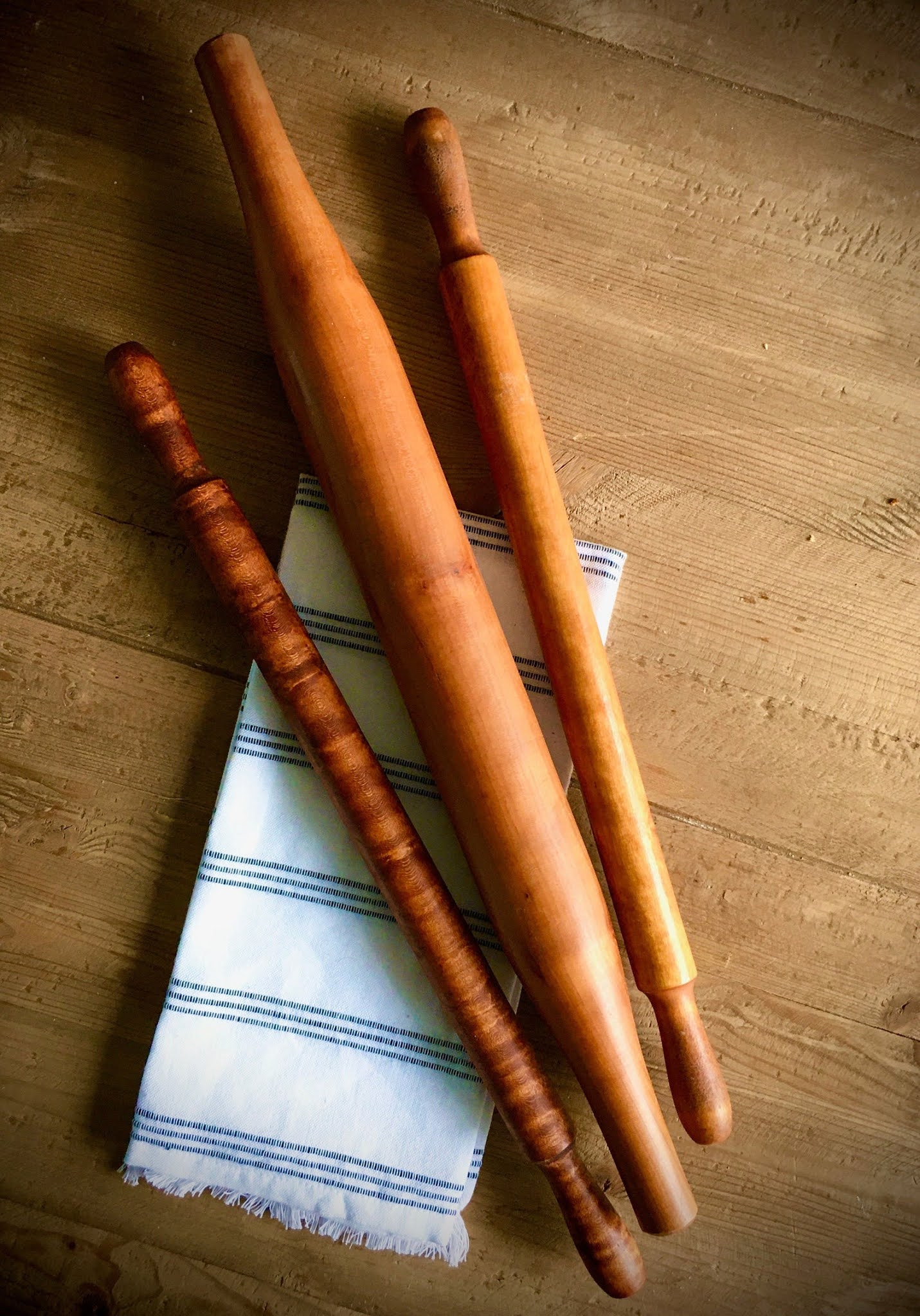 |
| Source | Shop More Like This |
What is it with all of these baking and kitchen related items, amiright?! Well, it’s really due to the fact that when we think of the farmhouse lifestyle of a hundred years ago, we often think of our great-grandmothers making and preserving food. They spent long hours engaged in the task of feeding their families, and so there’s something incredible homey about the tools of the trade.
Rolling pins vary so much in style and size, and they look amazing when clustered in groups. My favorites are the ones that still retain the chippy painted handles.
13. Demijohns
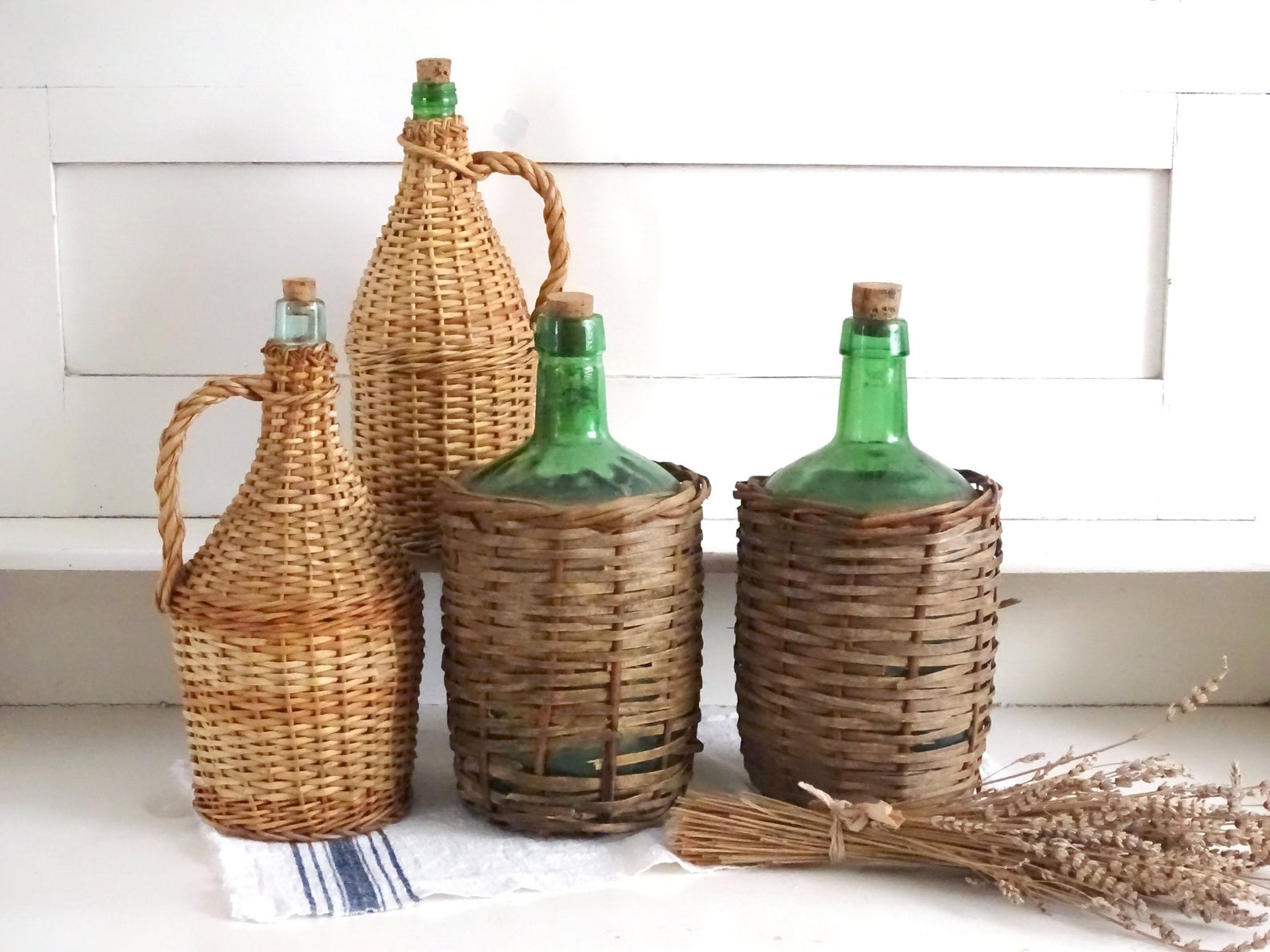 |
| Source | Shop More Like This |
Demijohns are glass jugs used, historically, for storing water or fermenting liquids such as beer and wine.
Technically speaking, demijohns are the wicker-wrapped versions of the jugs, and the plain glass jugs are called carboys (from the Persian word qarābah, or qarrāba in Arabic, meaning “big jug”). But these days, you’ll see demijohn used to refer to both the plain and wicker wrapped varieties. If you want to be completely accurate while talking to other vintage lovers, use the appropriate word–but don’t worry that anyone will look at you sideways if you refer to the plain glass jug as a demijohn.
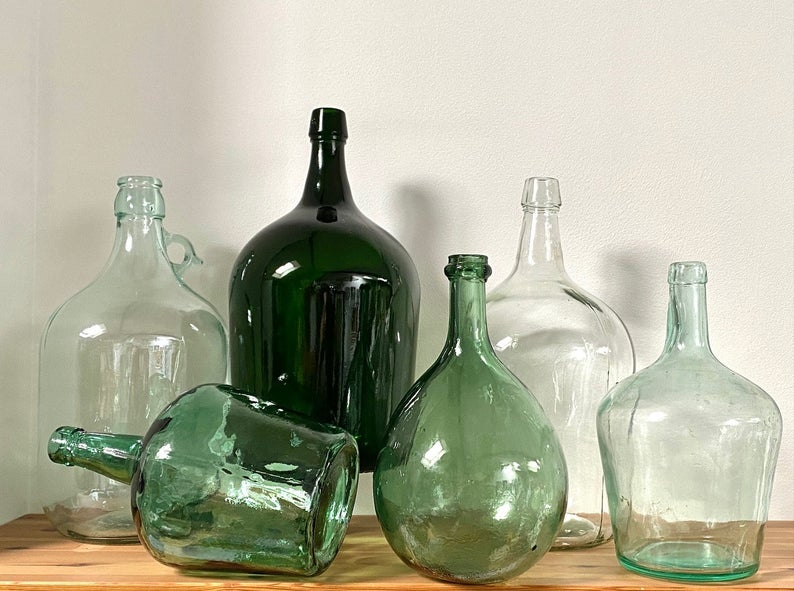 |
| Source | Shop More Like This |
Most people assume that the word demijohn is French, but etymologists aren’t certain about the origin. The word first appeared in the French language in the 1600s, but there was also a Persian town of Damghan that some historians believe could be the original reference.
14. Dough Bowls
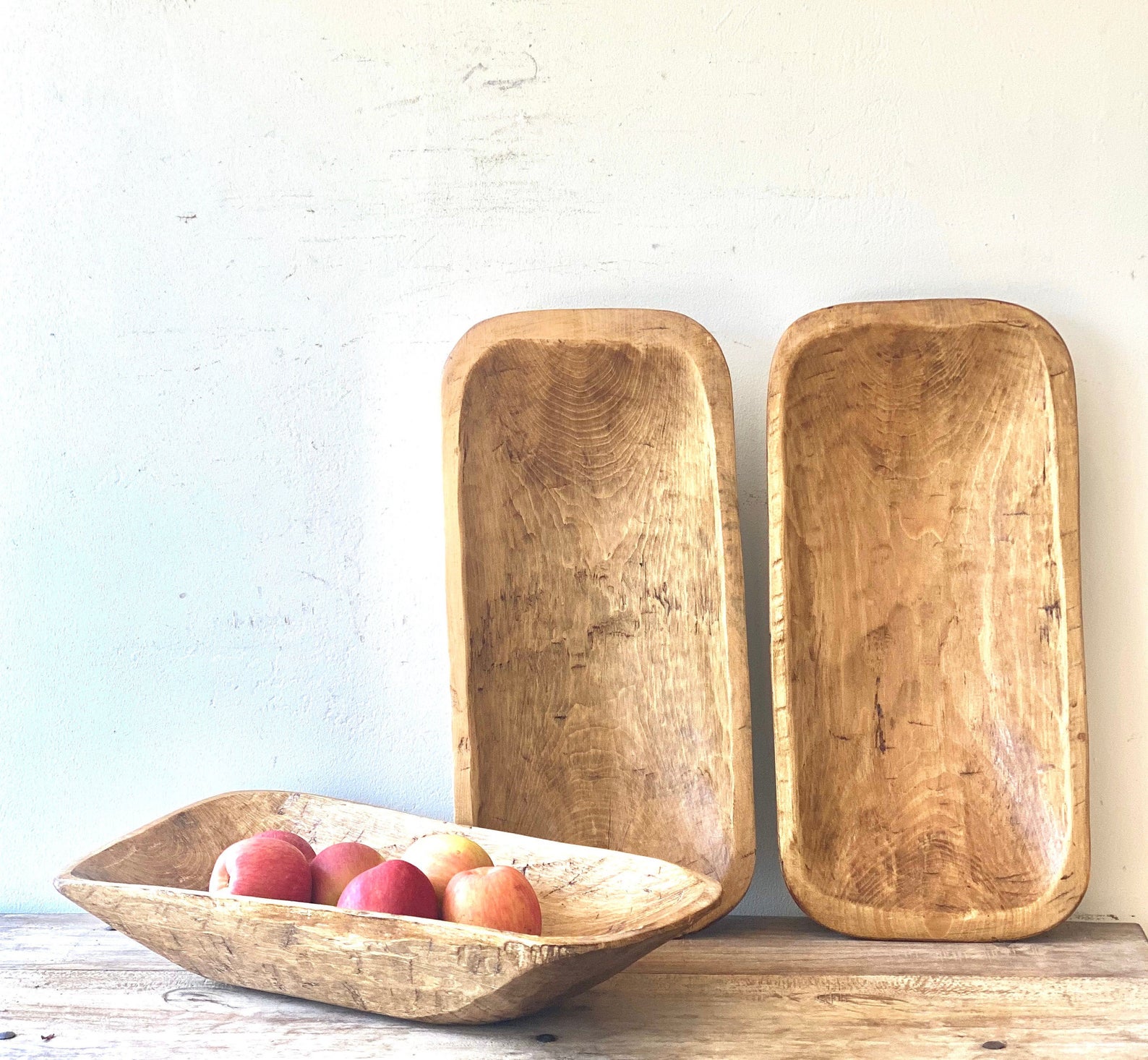 |
| Source | Shop More Like This |
Really? Another bread related item? I know, but as I’ve said before, farmhouse enthusiasts love evoking those feelings of cozy, rustic, rural life, and bread making was a big part of that lifestyle because it’s such a staple in the human diet.
This was a standard piece of kitchen equipment for kneading and rising dough for hundreds upon hundreds of years, so of course it’s going to fit perfectly in the vintage farmhouse aesthetic. Today, you will often see the larger troughs filled with decor items and used as a centerpiece on a table. And there are many candle makers who now use smaller versions as a vessel to hold their scented wax concoctions.
15. Tobacco Baskets
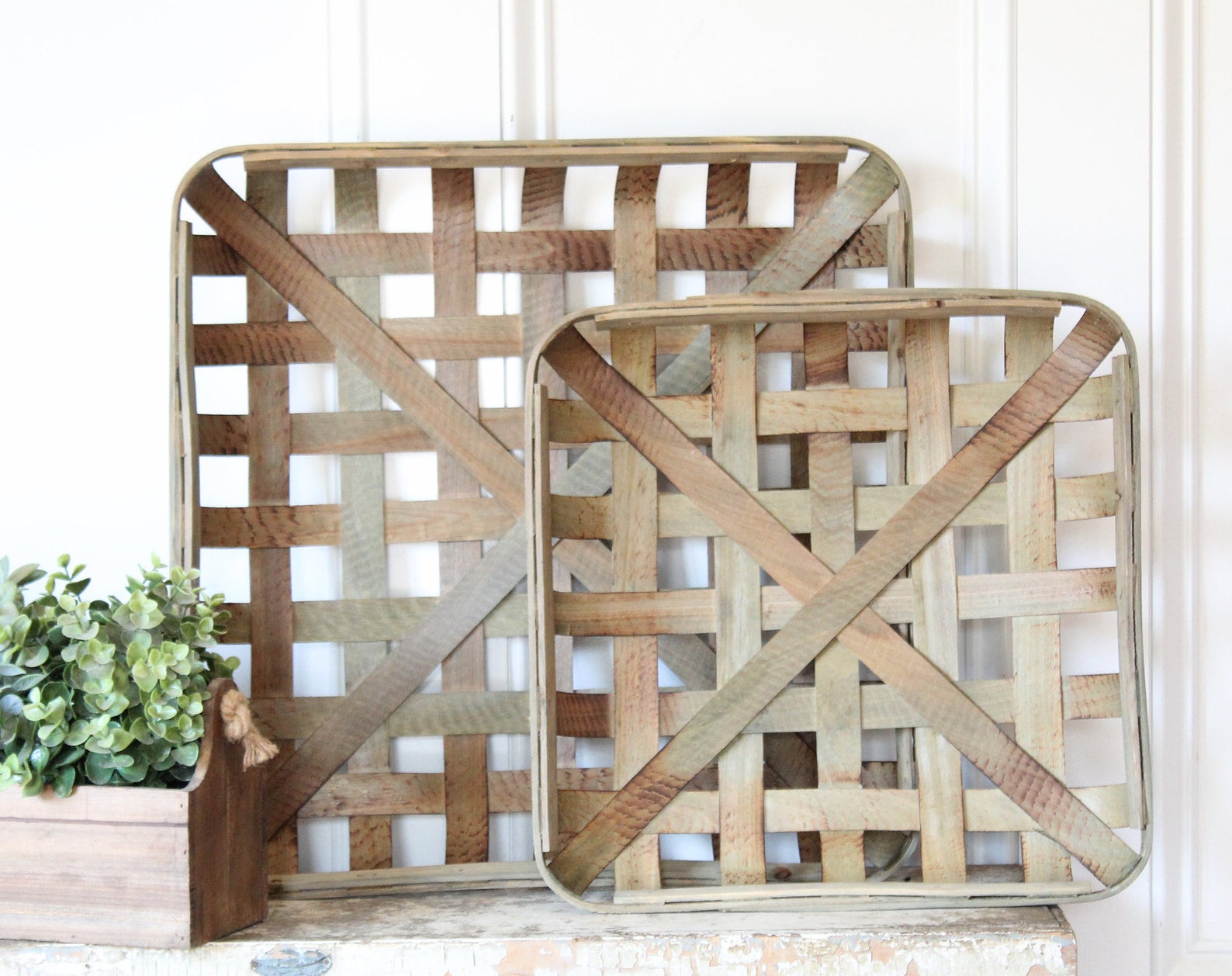 |
| Source | Shop More Like This |
There are a lot of misconceptions about how tobacco baskets were used, and you’ll hear many incorrect assumptions. Here’s how they really came about.
Back in Colonial America, tobacco was a staple crop for exporting. Contrary to popular belief, tobacco baskets were not used for harvesting or drying tobacco leaves. The leaves of the plants were picked by hand, and then several leaves would be bound together and tied to sticks that hung in barns to cure.
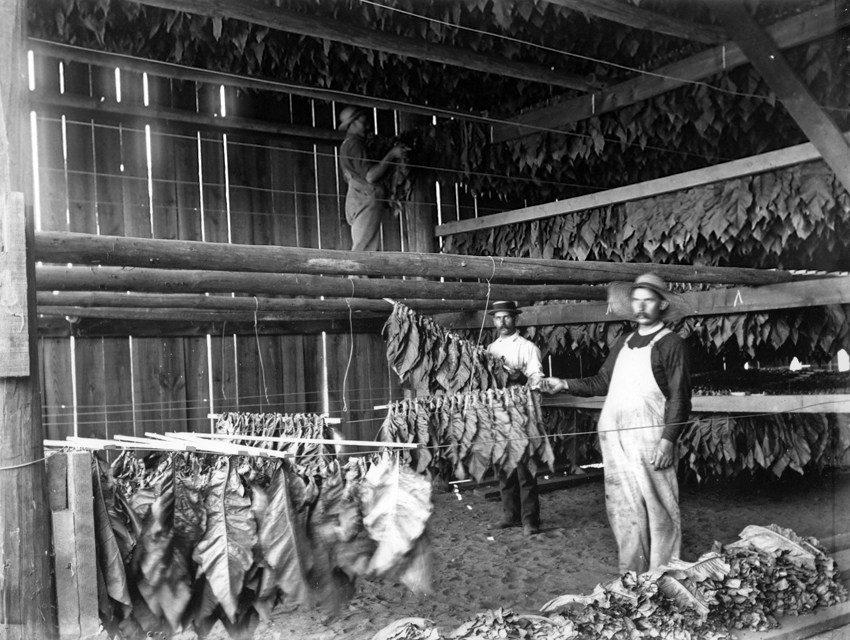 |
| Source |
The farmers would then take their dried tobacco leaves to the auction house. Originally, they would pack the leaves into barrels which each held about 1,000 pounds of leaves, but this quickly became problematic as unethical farmers would try to cheat their wholesale buyers. They would fill the bottom of the barrels with inferior leaves, or even rocks, and then layer the nicest leaves at the top.
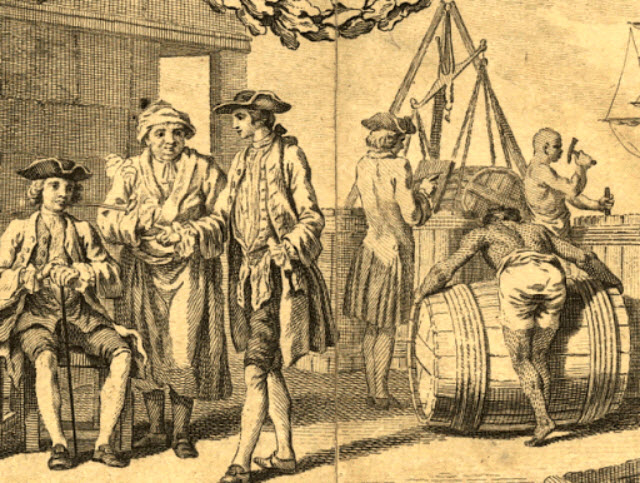 |
| Source |
This meant that the auction house rules changed so that the leaves would be dumped out on the floor of the market for full inspection. Again, though, this was a problem because the market floor was dirty and covered with mud and manure (remember, horses and mules were the transportation of the day!).
It was the R. J. Reynolds company that came up with the idea of stacking the leaves in these flat baskets to keep them clean and off the ground at market. This method actually continued all the way into the late 1980s before the demand for tobacco baskets finally tapered off due to new technologies. Isn’t history fascinating?!
16. Church pew benches
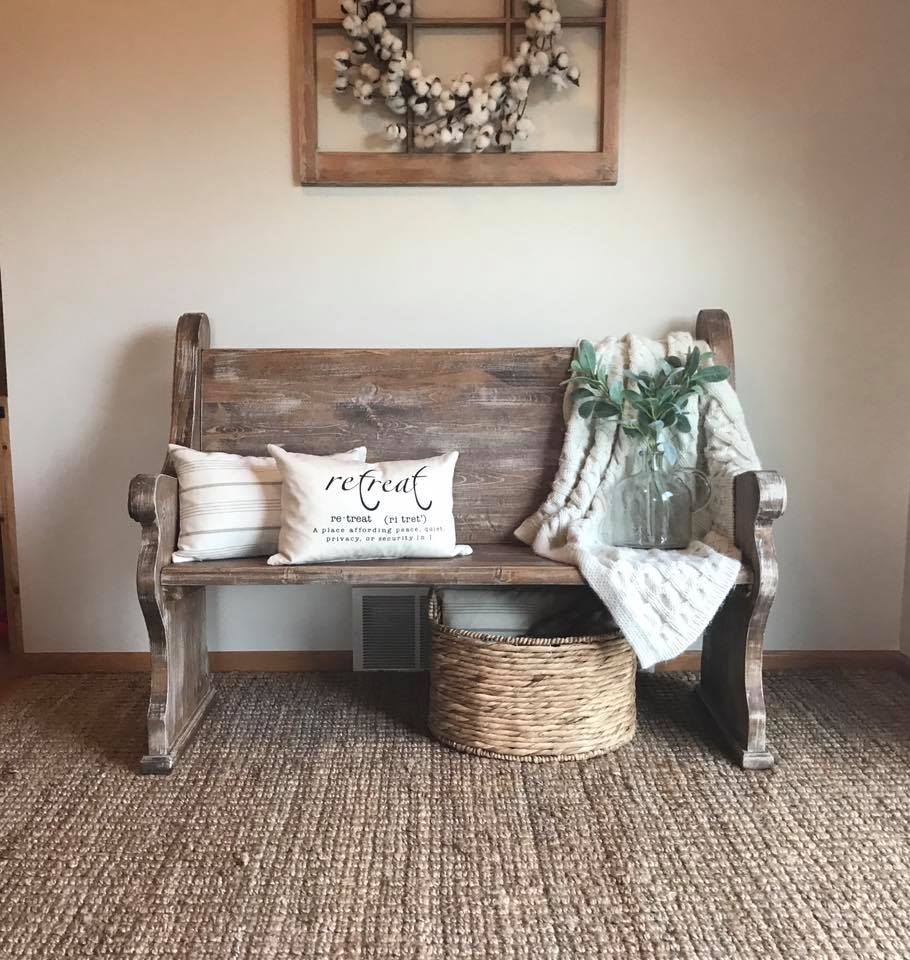 |
| Source | Shop More Like This |
I intentionally avoided included furniture in this list because that’s really an entirely separate chapter of vintage farmhouse styling. In this guide, my goal was to provide you with a list of decor items that would capture the aesthetic. But this was one piece that I couldn’t leave out because they’re so, so, so popular and also incredibly hard to find.
So if you’re lucky enough to run across an old pew at a decent price while you’re out hunting for vintage treasures, you absolutely must snap it up. Even if you have no idea where to put it–I promise you that you won’t regret it!
Pews work great both as a bench in an entryway or mudroom, or also at a farmhouse style dining table. I’ve even seen them used at the end of a bed. No matter how you style it–gorgeous!
Antique pews are, in fact, so uncommon (unless you’re willing to pay a LOT of money for one) that there’s a new category of home-based woodworking businesses that spend their time specifically devoted to making reproductions of these gorgeous benches, like the one in the photo above.
Nope, they still aren’t cheap. Not only are they incredibly labor intensive, but sourcing the high quality materials to make them comes at a premium as well. So be prepared to make an investment if you purchase one of these, and then adore it as a new family heirloom that you can pass down to your children or grandchildren one day.
17. Whisk brooms
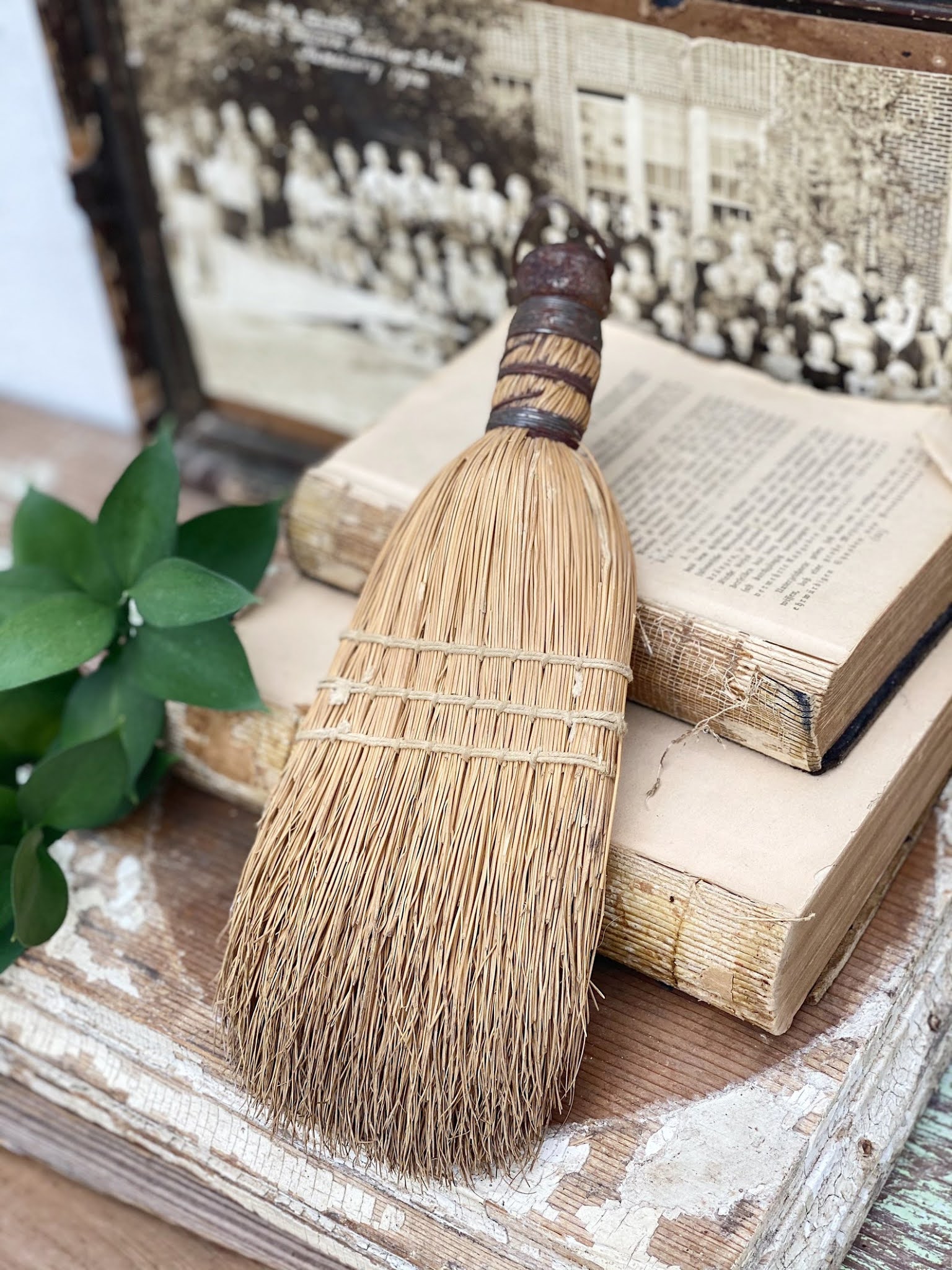 |
| Source | Shop More Like This |
I have to admit that this is one of the weirder pieces of vintage farmhouse decor that’s popular. I mean, a hand broom is kind of a notoriously dirty item, right? But at the same time, they look so cool styled on a wall!
I recently shared the whisks brooms I’ve started collecting with plans to eventually hang them on our laundry room wall. They add great texture to your decor!
18. Old books
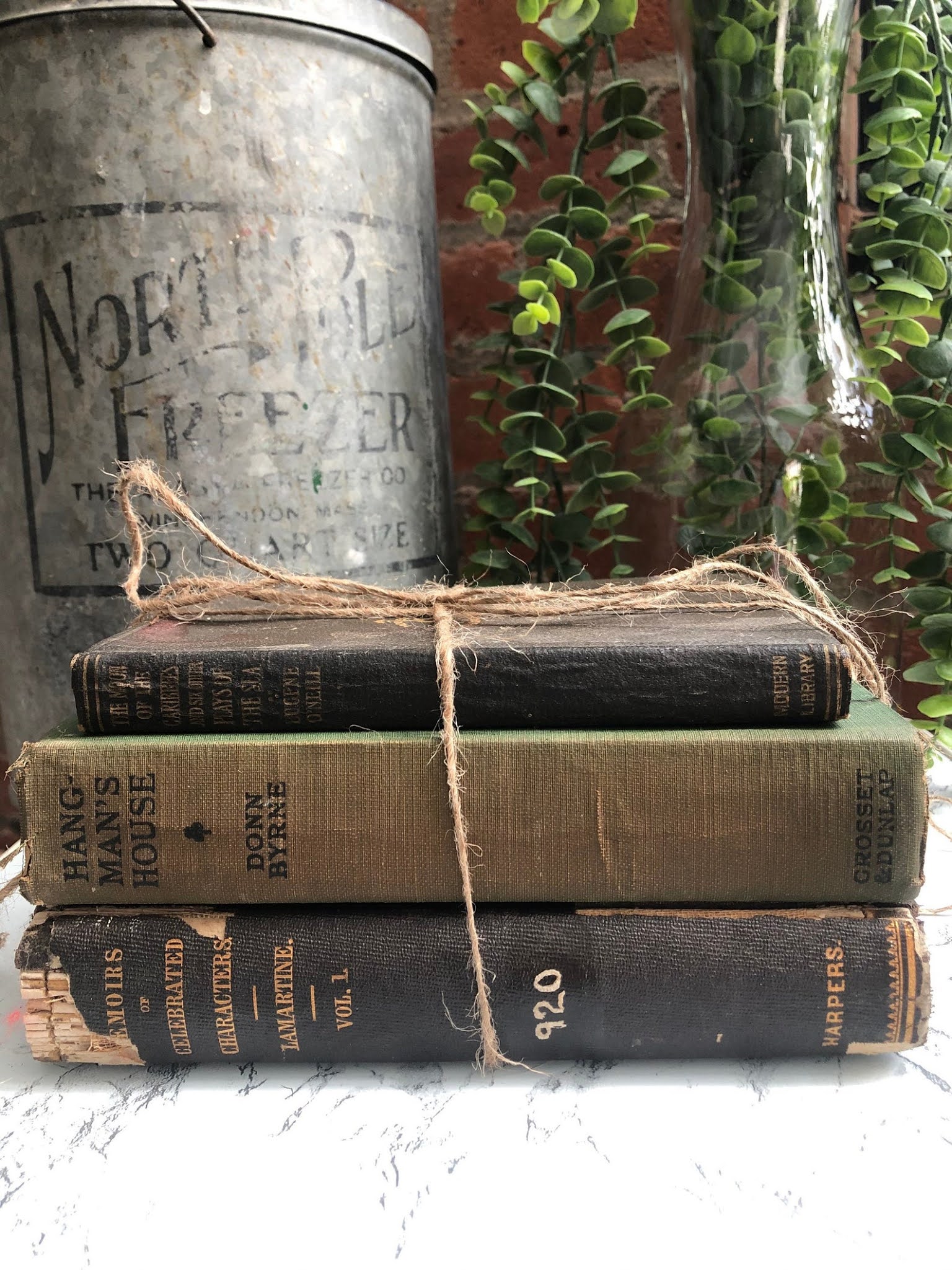 |
| Source | Shop More Like This |
I’m a vintage book hoarder. I admit it. Old books are something I just absolutely adore, and there are so many ways to use them in your decor.
For starters, they’re perfect for layering and adding height to vignettes. You’ll find them used liberally throughout our home.
But I also love the variety of vintage colors and even the titles, which can be super fun to work into a themed vignette. For example, finding book titles that contain the names of flowers for a spring garden themed display. Or old choir books in red and green to use at Christmas. I really can’t get enough of them!
19. Jadeite
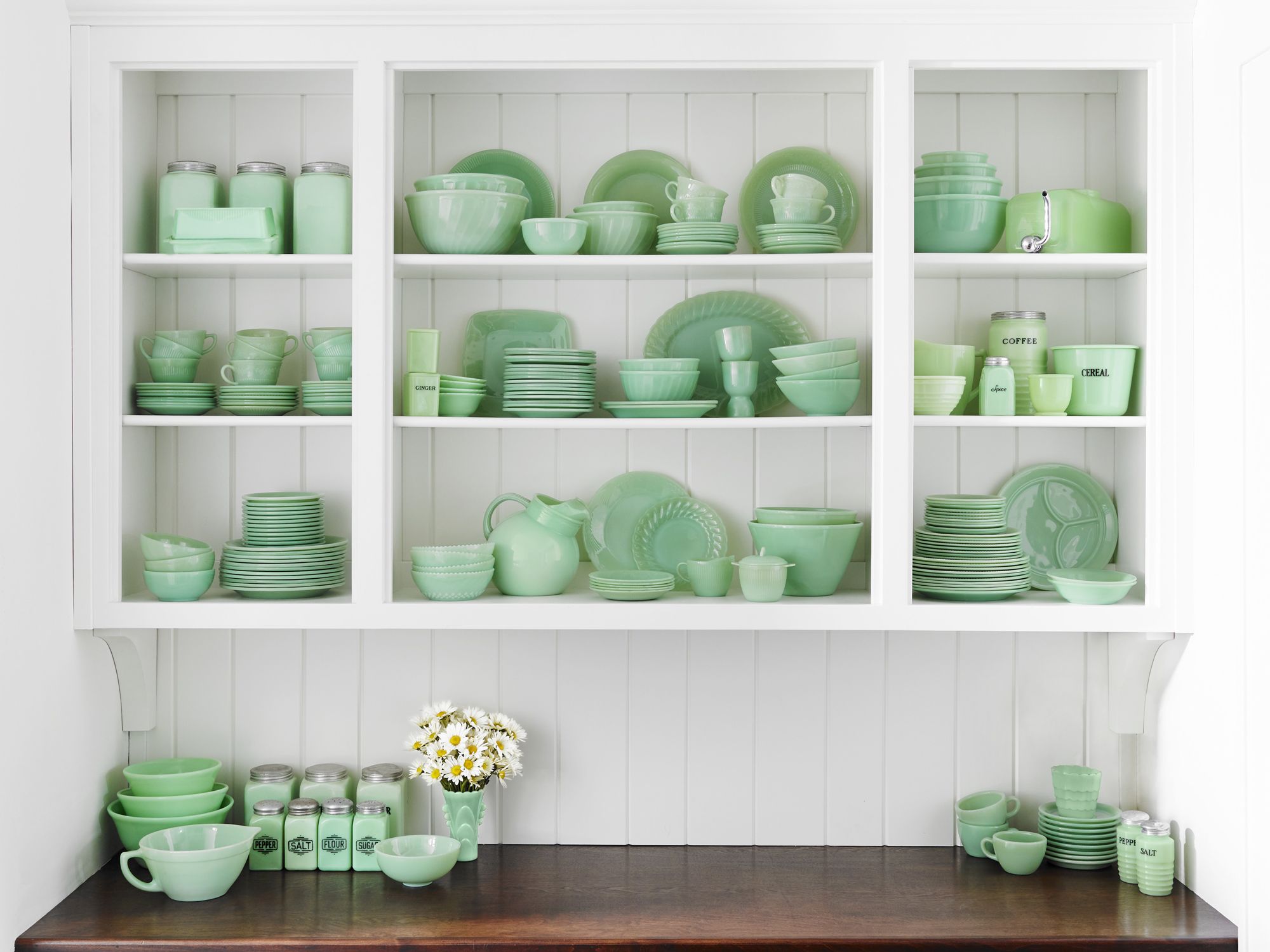 |
| Source | Shop More Like This |
Just as I mentioned with ironstone, not every type of green glassware is jadeite. Jadeite was first produce by McKee in the 1930s, but really became popular in the 1940s-70s when Anchor Hocking began producing their Fire-King line.
One of the reasons it’s so popular in vintage farmhouse styling, aside from the fact that it’s undeniably pretty, is that green is a common color in the farmhouse aesthetic. Being a basic color of nature, it works equally well against white shiplap or rustic stained wood.
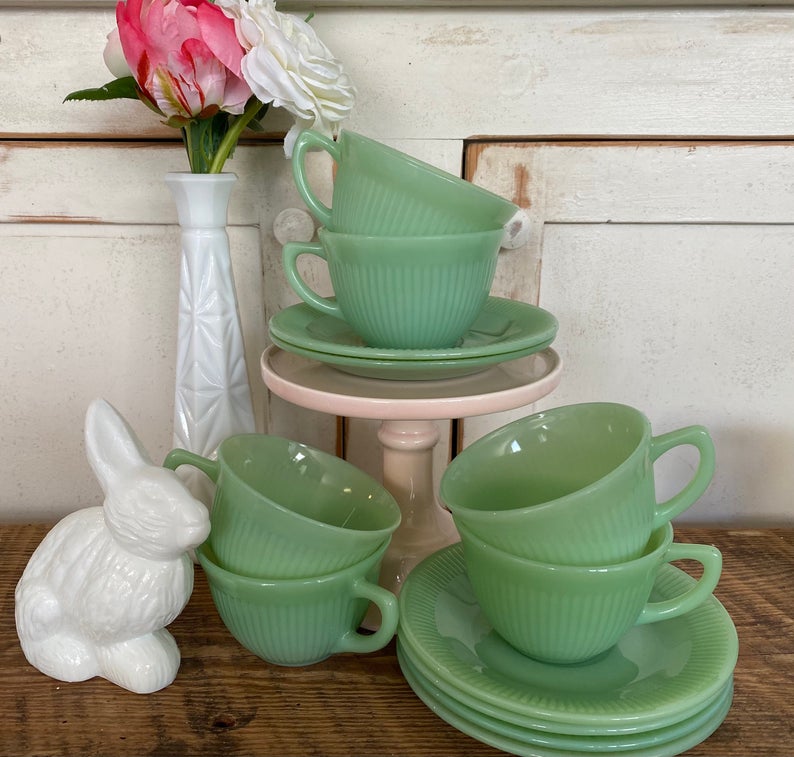 |
| Source | Shop More Like This |
Another reason it’s so popular is that it’s still fairly easy to find at affordable prices. I wouldn’t be shocked to find pieces at a thrift store for a dollar or two, but if you’re a hard core collector, you’re probably going to be searching antique shops for the more rare finds (which can be quite spendy).
In my own collection, I have a beautiful jadeite candy dish that I picked up for only 50 cents while garage sale-ing with my sister a few summers back. That’s truly how easy and affordable it is to start your own jadeite collection!
20. Enamelware
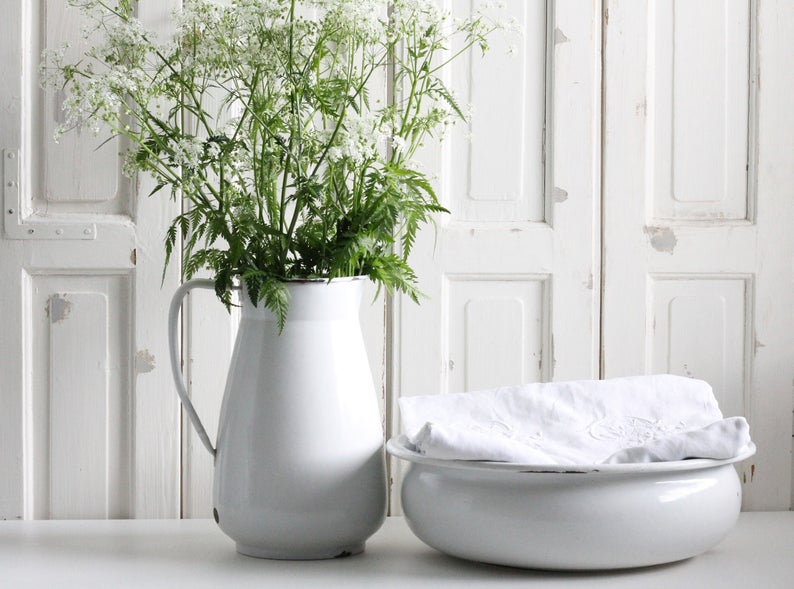 |
| Source | Shop More Like This |
Enamelware, particular the pieces that are white with black rims or accents, are especially popular with the farmhouse crowd. Even reproduction pieces (which are quite indistinguishable to an untrained eye) are found in abundance.
So, what is enamelware anyway?
Some people think that these are painted metal pieces (and that’s usually true of reproduction pieces), but authentic, vintage vitreous enamel is actually glass that’s applied over metal at high temperatures. It became popular because it’s easy to clean and won’t burn or fade, but the downside is that it chips and cracks easily under stress.
For those who love the vintage farmhouse aesthetic, chippy isn’t a negative! In fact, those bumps and bruises of a truly vintage item only make it more beloved.
21. Old Cameras
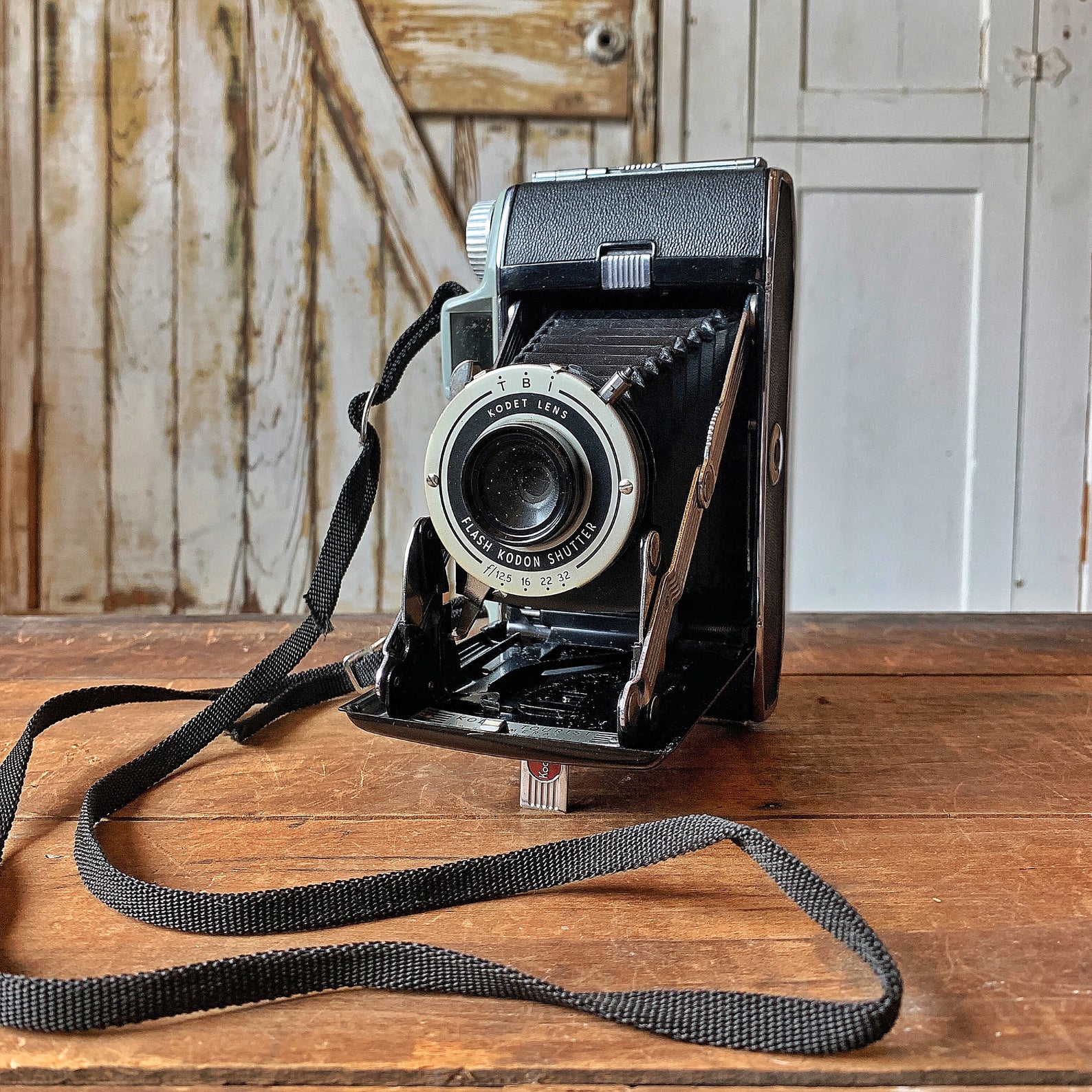 |
| Source | Shop More Like This |
There are certain vintage items that grabbed my heart more than others, and I think one of the reasons is because of how they were used as tools of the past. Cameras are one of those items because I like to romanticize all of the moments of history that they captured through the years.
Even if a camera only ever caught a family’s memories, they’re still incredibly special parts of our lives. But just imagine the stories they could tell throughout history! So collecting them is high up on my list.
But they don’t come cheap, by any means. Since I’m quite thrifty and because we’ve had a shop for nearly three years, I spend a great deal of time hunting and scouring for vintage items, so I would never want to pay more than $45-50 for a vintage camera.
Honestly, though, that’s about the lowest price you’ll probably ever find one anymore, so don’t necessarily adopt my penny-pincher attitude and pass up a treasure! But do watch for deals, like any of these ones, where the vendor is offering free shipping!
22. Alarm Clocks
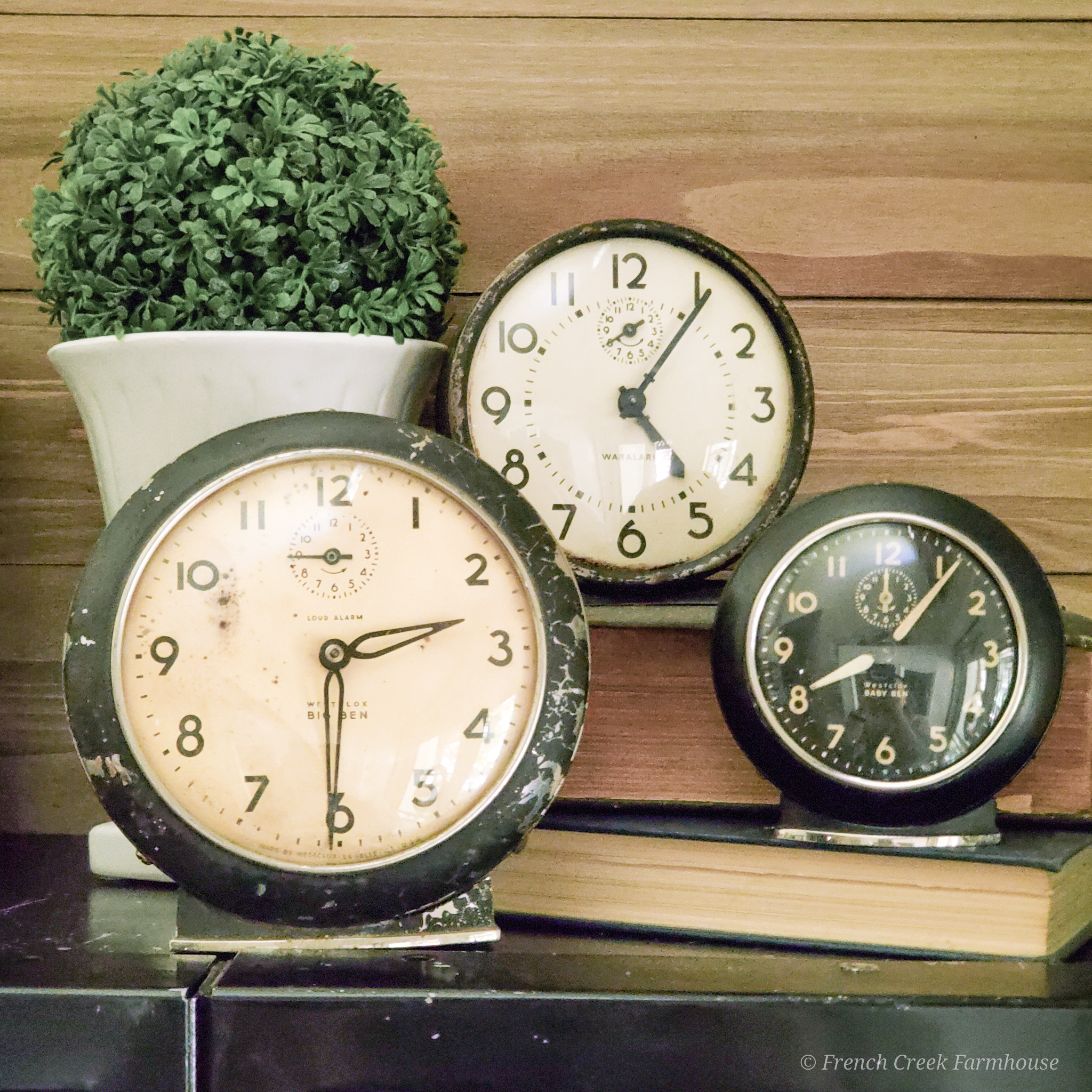 |
| Shop More Like This |
I’ve been collecting vintage alarm clocks for several years, and this is one of my collections where I actually do make an investment and purchase rare finds. In particular, I collect the Westclox brand of alarm clocks, and I think it’s really the history and story about these old clocks that first drew me in. There’s also something just so intriguing to me about humanity’s fascination with the passing of time, and what better way to visualize that than with clocks.
I wrote a detailed guide all about collecting Westclox, and it’s the very best place to get started with curating your own collection.
23. Antique Windows
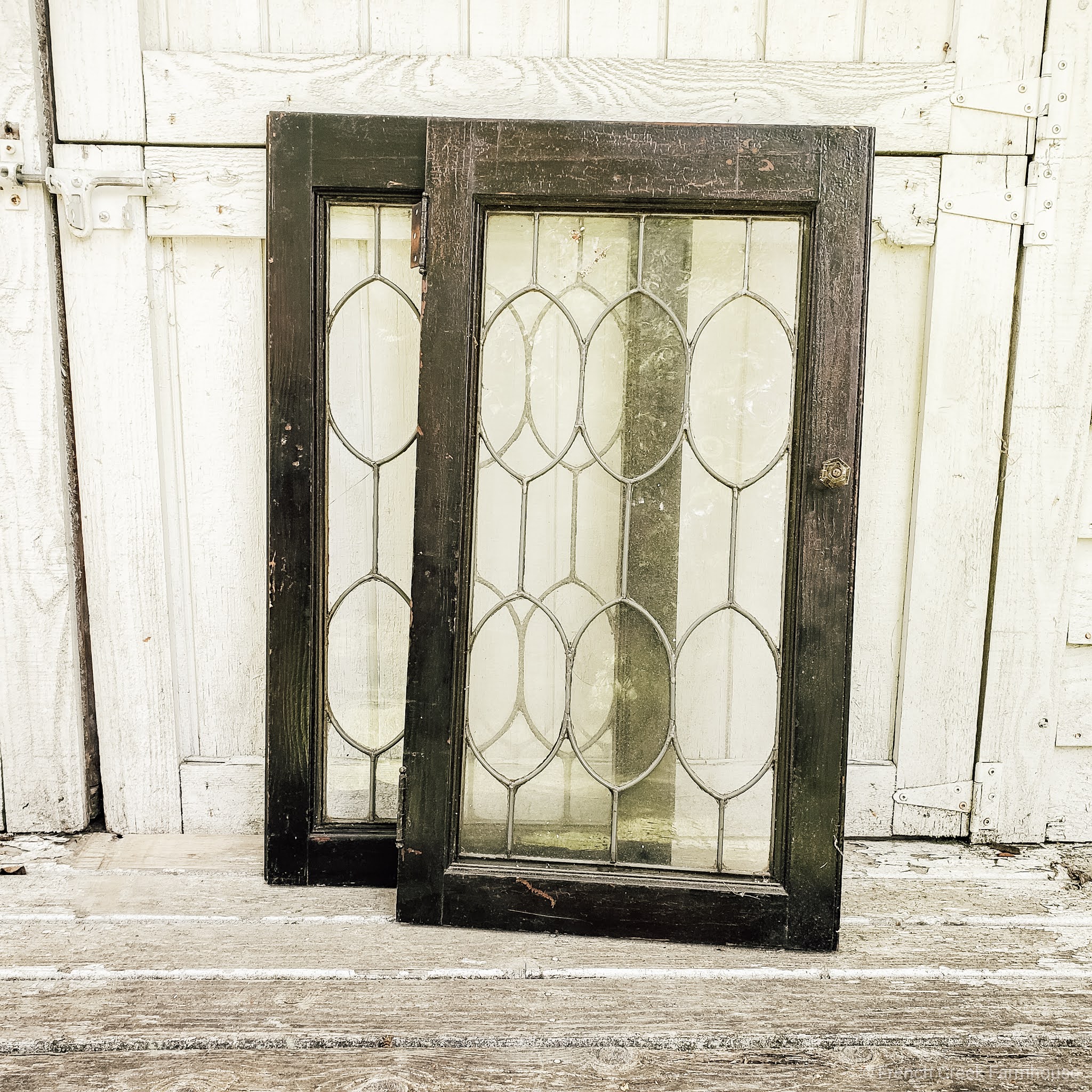 |
| Shop More Like This |
Although old windows are technically part of architectural salvage, they’re really a category all of their own when it comes to farmhouse styling. For the longest time, I had collected old windows but actually not hung them on our walls. This sounds crazy, right?
But the fact is, I was so afraid of doing it wrong and having them fall off that I just didn’t know where to start. Fast forward to now, and I am nut about finding wall space to hang vintage things that I love! Life is simply too short not to enjoy things!
If that’s where you want to be in your decorating abilities, then you certainly need to take a look at this comprehensive tutorial I wrote alllll about how to (safely and securely) hang heavy stuff on the wall. I go into all the detail in that post for every type of heavy thing you might be able to find on your next vintage treasure searching trip, but if you want a tutorial specifically about hanging vintage windows, I’ve got that too! We even made a whole video for you all about it!
These three posts will teach you everything you need to know to hang your vintage finds in your home!
How to (Safely) Hang Heavy Stuff on a Wall
How to Hang Old Windows on the Wall
How to Hang Vintage Windows from the Ceiling
24. Antique Typewriters
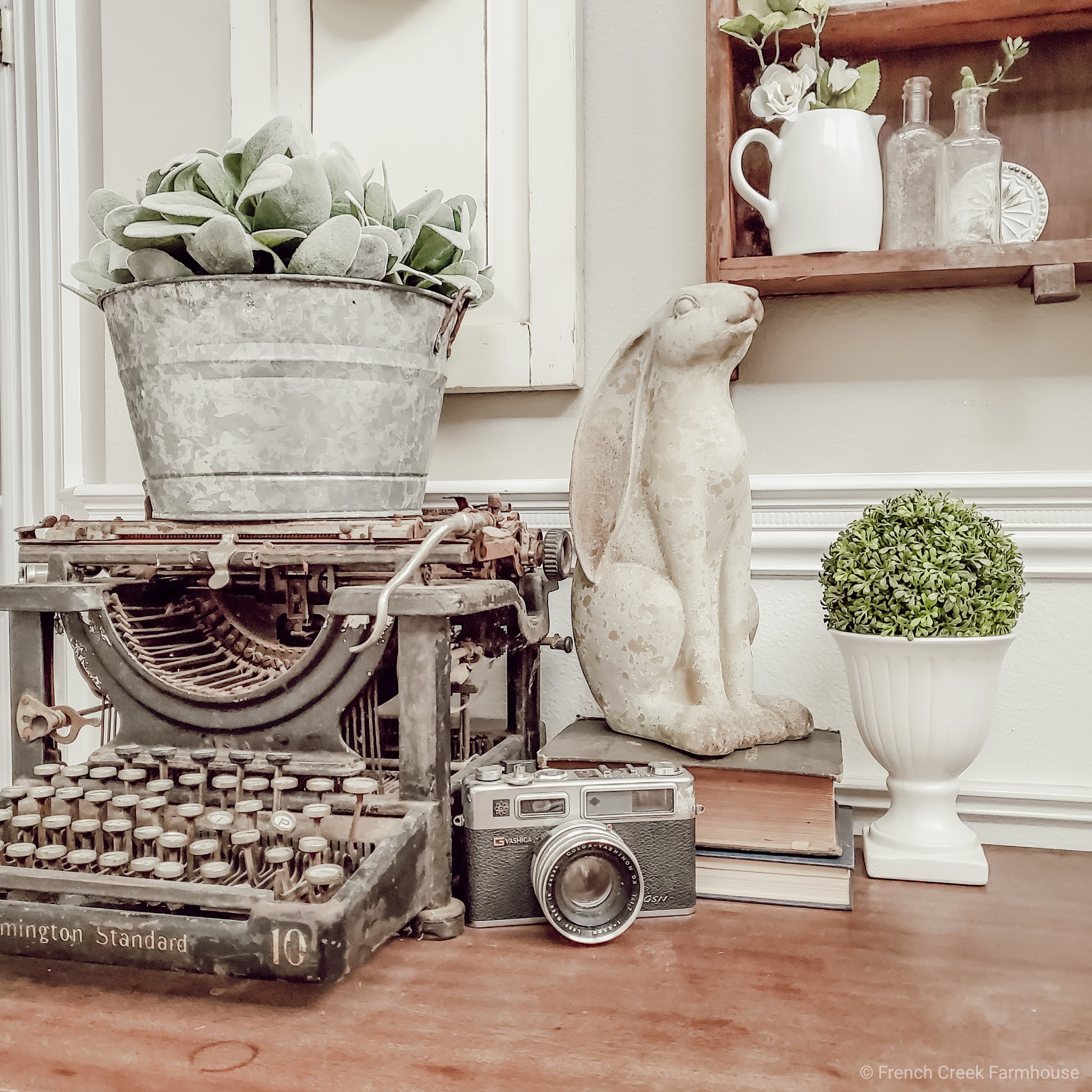 |
| Shop More Like This |
Super heavy, awesomely clunky, old typewriters are the other vintage item that I like to romanticize. I think to myself, just imagine what stories might have been written here! What love letters might have been crafted! What important documents could have started right here!
Even if it’s not true, it’s still fun to imagine. And they’re so amazing in vintage farmhouse decor.
If the rollers are still in good working order, one of my favorite things to do is insert a piece of paper with a meaningful quote on it, printed on my computer (of course) in large enough font to be read across the room…but all with a vintage vibe!
25. Mason Jars
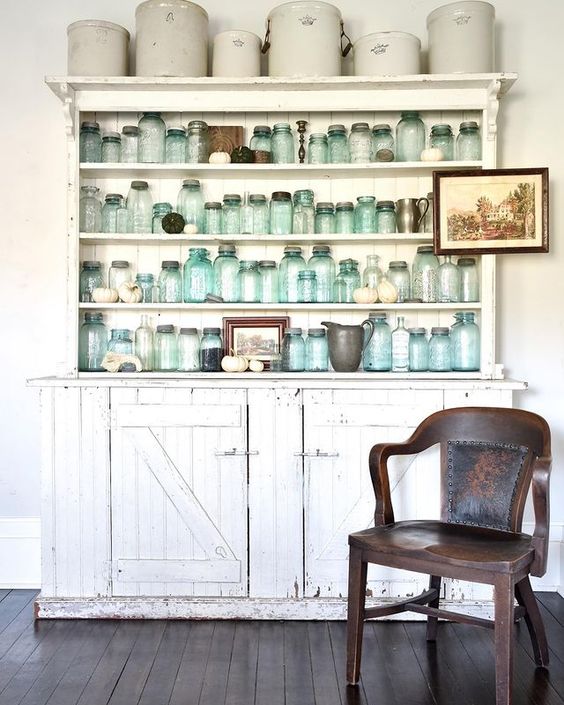 |
| Source | Shop More Like This |
Although I said I wasn’t listing these 25 vintage farmhouse decor items in any order, I do think I subconsciously saved the best for last.
If there’s one thing I have researched and dug into deeply over the years, it’s the history of Ball Mason Jars. Several years ago, I wrote another very long post (like this one! ha!) that was all about these amazing jars, and it is still read thousands of times every month by new readers–maybe that’s even how you arrived here!
If you’d like to learn more about Ball Mason Jars, including how to determine how old they are and some fun history to entertain your house guests while they marvel at your own collection, you can find my guide here.
I hope this tutorial has given you loads of ideas for decorating your own home with a vintage aesthetic! And, P.S., if you love searching for and collecting vintage treasures, you’ll absolutely adore my Vintage Hunting Journal! Get this printable for free, right here!

